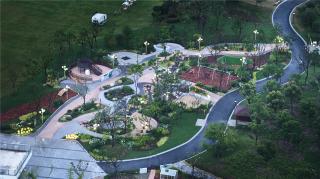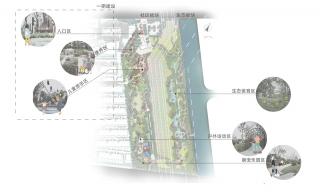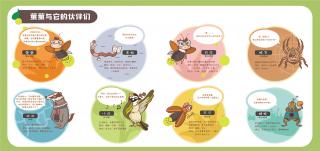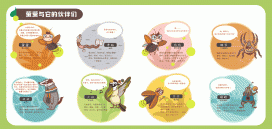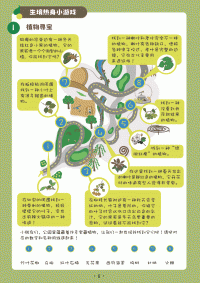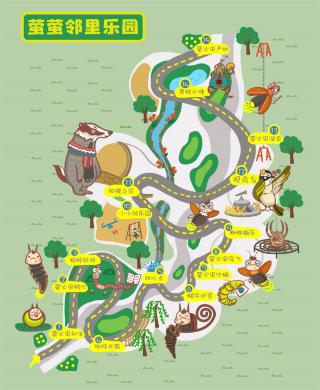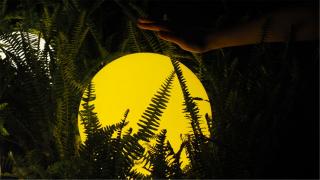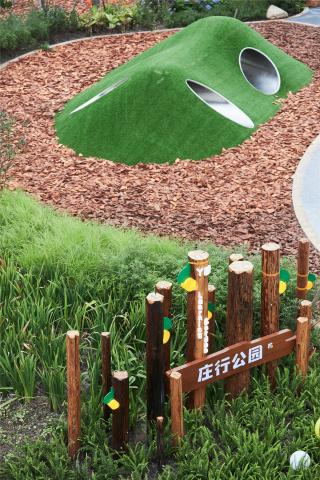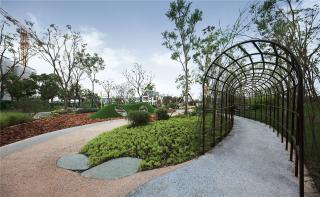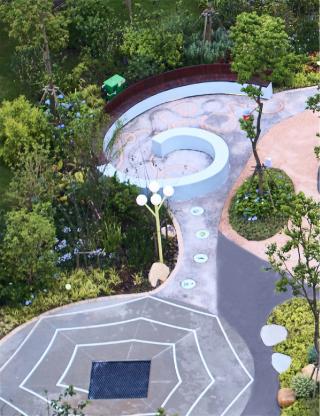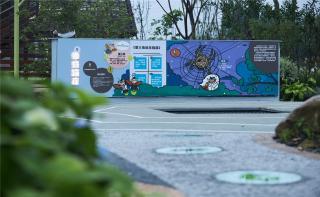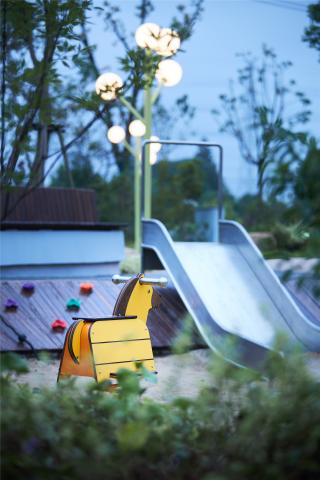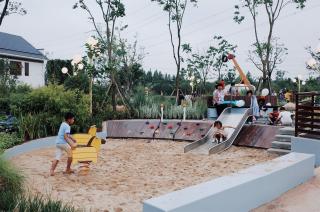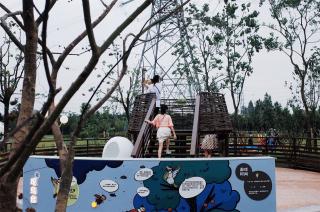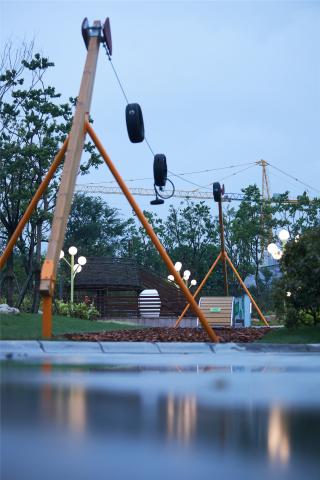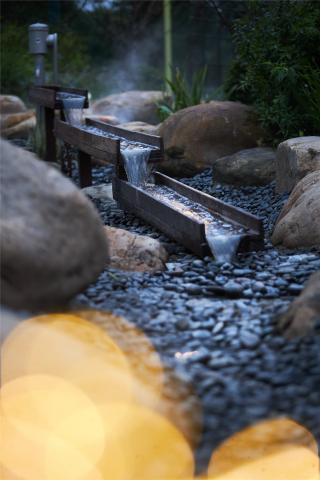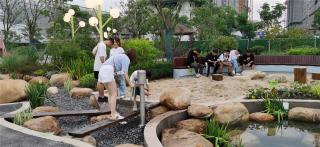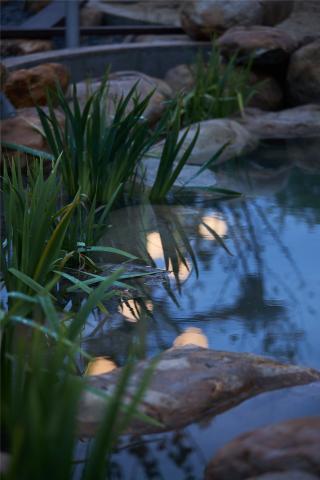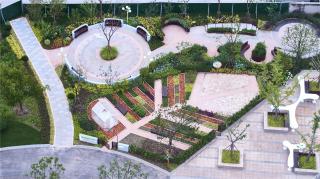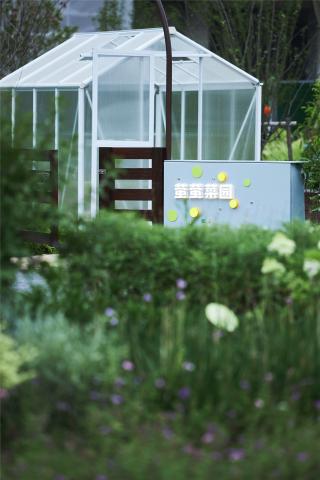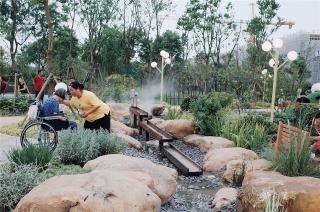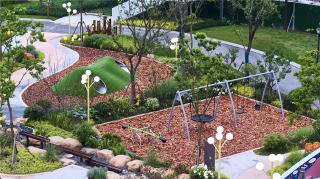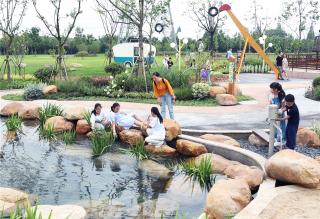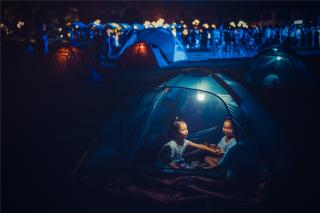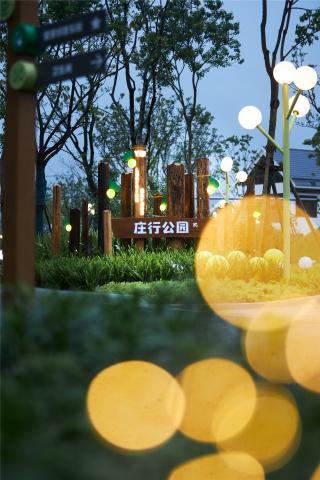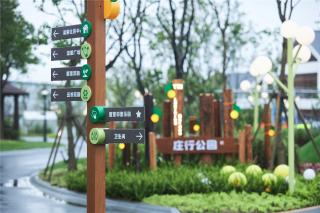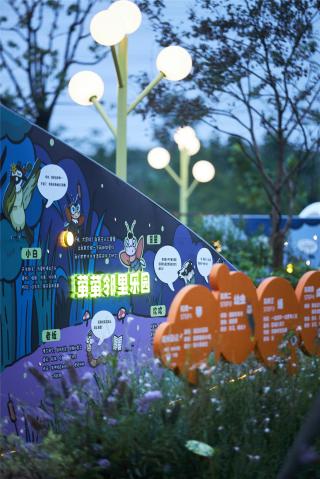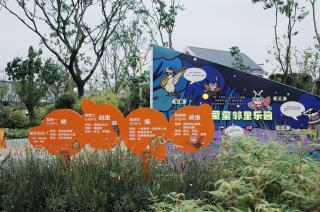項(xiàng)目概況
Project Overview
該項(xiàng)目位于上海奉賢新城���,占地約5公頃���,處于規(guī)劃綠廊與生態(tài)走廊中間���,同時(shí)位處于居住生活圈,周邊有多處社區(qū)及學(xué)校����,同區(qū)域內(nèi)有莊行郊野公園�����,社區(qū)基礎(chǔ)與生態(tài)基地條件良好���。
基地原本是一處垃圾堆放地�����,2019年改造為城市綠地���。但場地內(nèi)缺乏設(shè)施與空間滿足周邊居民日益增長的休憩交流需求����。并且����,近期與基地同在一個(gè)區(qū)內(nèi)的齊賢村發(fā)現(xiàn)了上海規(guī)模最大的螢火蟲(黃脈翅螢)棲息地,同時(shí)也在基地1.3公里處發(fā)現(xiàn)了十多只狗獾���。狗獾是上海市重點(diǎn)保護(hù)野生動(dòng)物����,也是上海的一種“極小種群物種”�。從1997年到2007年,據(jù)相隔10年的上海兩次野生動(dòng)物資源調(diào)查和日常監(jiān)測�����,上海郊區(qū)狗獾的種群已呈孤立的散點(diǎn)狀分布���,全市種群數(shù)量不足三十只����,如不采取有效措施,生存狀況堪憂���。黃脈翅螢與狗獾棲息地的存在對項(xiàng)目基地的生態(tài)設(shè)計(jì)提出了極高的要求��,基地的特殊條件與周邊珍貴的生態(tài)資源使該地塊的開發(fā)與設(shè)計(jì)充滿了挑戰(zhàn)��。
The project is located in Fengxian New Town, Shanghai, covering an area of about 5 hectares. It is located between the planned green corridor and the ecological corridor. It is also located in the residential living circle. There are many communities and schools around it. There is a Zhuanghang Country Park in the same area. The community foundation and ecology The base is in good condition.
The base was originally a garbage dump, which was transformed into an urban green space in 2019. However, there is a lack of facilities and space in the site to meet the growing demand for leisure and the exchange of surrounding residents. In addition, the largest firefly habitat in Shanghai was discovered in Qixian Village, which is in the same area as the base, and more than a dozen fireflies listed as endangered by the International Union for Conservation of Nature were also found 1.3 kilometers away from the base. Species red list of dog badgers. The badger is the largest existing terrestrial wild mammal in Shanghai. It is a key protected wild animal in Shanghai, and it is also a "very small population species" in Shanghai. From 1997 to 2007, according to two wild animal resource surveys and daily monitoring in Shanghai 10 years apart, the population of dog badgers in the suburbs of Shanghai has been distributed in isolated spots. The population of the city is less than 25. If effective measures are not taken, The dog badger will soon be completely extinct in the suburbs of Shanghai. The existence of the habitats of yellow-veined winged fireflies and dog badgers puts forward extremely high requirements on the ecological design of the project base. The special conditions of the base and the precious surrounding ecological resources make the development and design of the plot full of challenges.
▼ 螢螢鄰里樂園鳥瞰
Aerial view of Firefly Neighborhood Park ? 奧沙-亞瑟
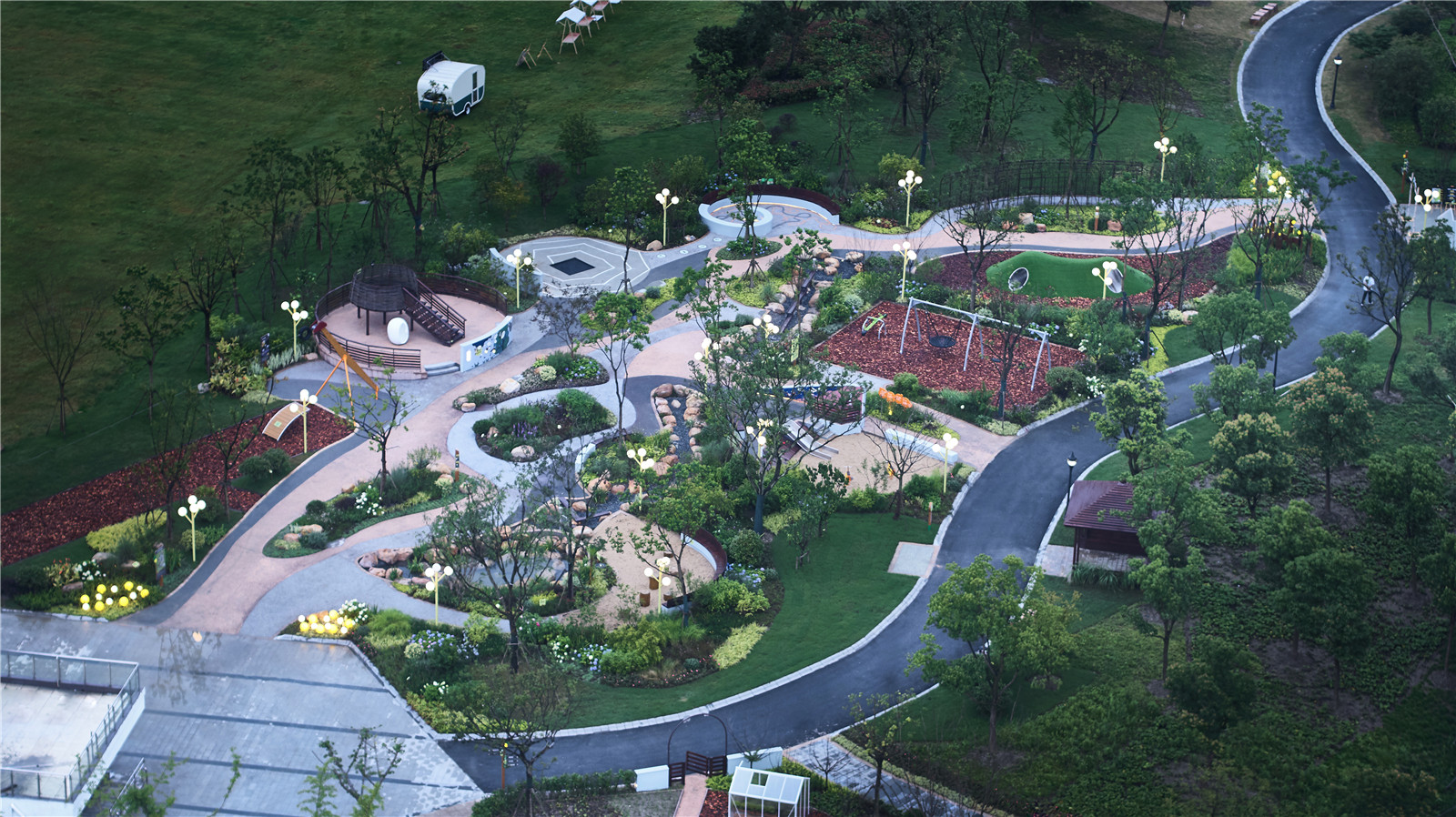
設(shè)計(jì)策略
Design Strategy
現(xiàn)有場地是由垃圾填埋場改造而來�����,場地上方有高壓線��、地下埋了液化油管���,對人群活動(dòng)與景觀種植都起到了一定的限制?��;谶@樣的情況,設(shè)計(jì)中將場地東側(cè)設(shè)置為以生態(tài)保育為主的生態(tài)板塊���,而主要的人群活動(dòng)放在場地西側(cè)的社區(qū)板塊����。整體考慮周邊居住區(qū)、社區(qū)養(yǎng)老院的適用人群需求��,綜合考量全齡段日?�;顒?dòng)����,將社區(qū)板塊分為了康養(yǎng)區(qū)/親子游樂區(qū)/戶外運(yùn)動(dòng)區(qū)/萌寵樂園幾大分區(qū)。本次一期工程重點(diǎn)打造以鄉(xiāng)土明星物種螢火蟲為主題的親子游樂區(qū)�,和激發(fā)老人社會(huì)歸屬感及心理健康為出發(fā)點(diǎn)的康養(yǎng)區(qū)。
The existing site is transformed from a waste landfill. There are high-voltage lines above the site and liquefied oil pipes are buried underground, which restricts crowd activities and landscape planting. Based on this situation, in the design, the east side of the site is set as an ecological section focusing on ecological conservation, and the main crowd activities are placed in the community section on the west side of the site. Taking into account the needs of the applicable people in the surrounding residential areas and community nursing homes, and comprehensively considering the daily activities of the whole age group, the community section is divided into the health care area/parent-child play area/outdoor sports area/cute pet paradise. The first phase of the project focuses on creating a parent-child play area with the theme of the local star species fireflies, and a recreation area that stimulates the elderly's sense of social belonging and mental health as the starting point.
▼平面分析
Plane analysis
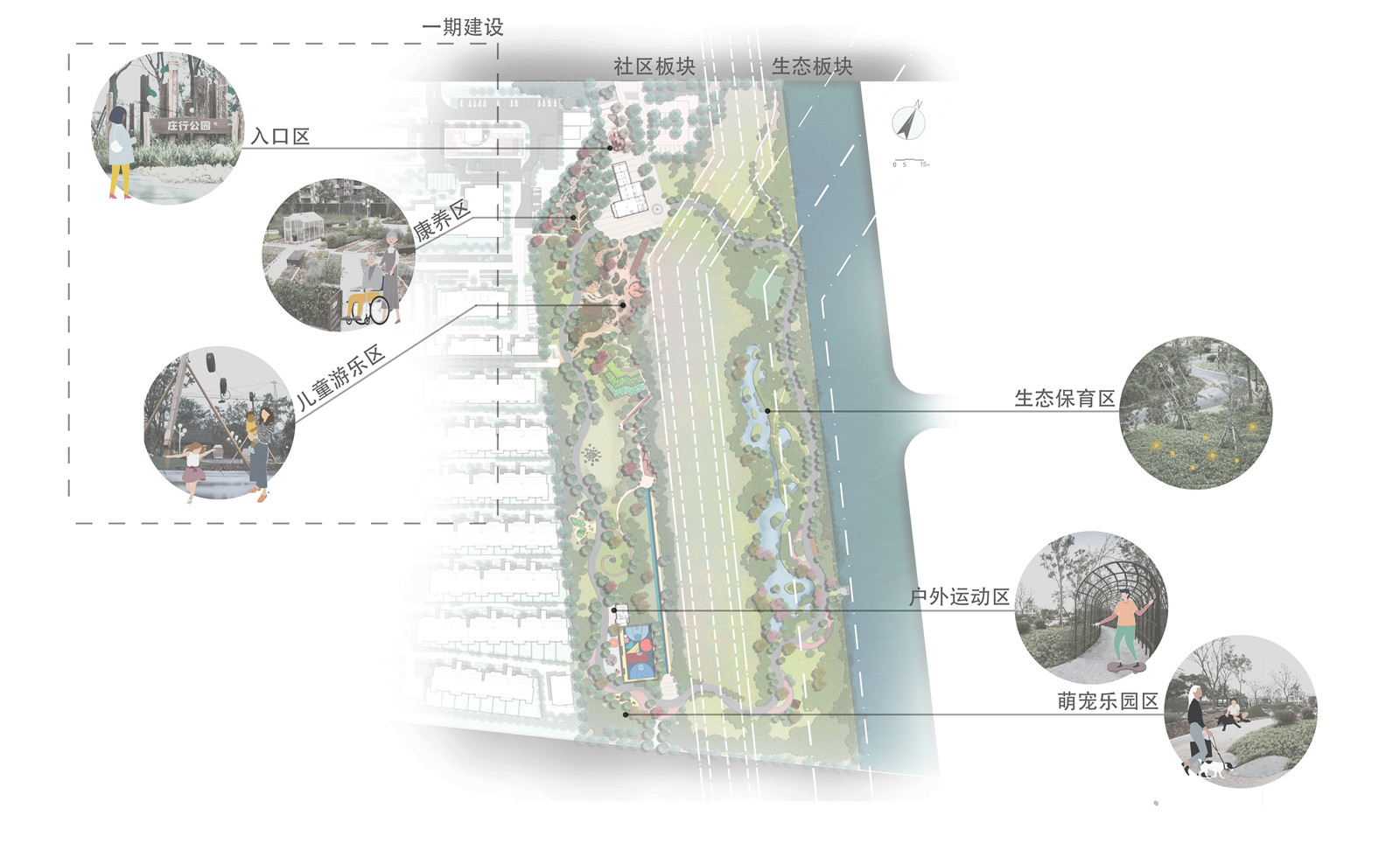
親子游樂區(qū)以鄉(xiāng)土明星物種螢火蟲——黃脈翅螢為主題���,以黃脈翅螢的卵����、幼蟲��、蛹到成蟲的四變態(tài)過程為主線��,串聯(lián)螢火蟲作為傘護(hù)種在自然環(huán)境里遇到的蚯蚓���、大腹園蛛����、狗獾、白頭鵯�、條背螢、飾紋姬蛙等各位“鄰居”�����。在整體的景觀敘事中����,將自然物種擬人化,并提煉其“鄰居”們的生境元素�����,通過空間設(shè)計(jì)的手法將其轉(zhuǎn)化為有趣���、互動(dòng)性強(qiáng)的景觀節(jié)點(diǎn)���。此外,結(jié)合景觀設(shè)計(jì)制作了一系列科普標(biāo)示����、導(dǎo)覽手冊、生境手冊以及引導(dǎo)親子參與互動(dòng)的系列活動(dòng)�����。希望通過這些內(nèi)容引導(dǎo)社區(qū)公園使用者(尤其是兒童)關(guān)注身邊的自然�,了解生境的重要性,并在社區(qū)活動(dòng)中促進(jìn)人與人����、人與自然的鏈接。
康養(yǎng)區(qū)設(shè)計(jì)關(guān)注老人精神層面的需求����,希望通過景觀設(shè)計(jì)打造一個(gè)被賦予安全感、舒適感��、歸屬感���、被尊重�����、自我價(jià)值的身心靈安放之地����。從老年人日常場景出發(fā)加入自然的力量,讓老年群體能夠在這里老有所學(xué)���、老有所依��、老有所養(yǎng)��、老有所樂�、老有所護(hù)��。設(shè)計(jì)針對老年群體的行為模式特征以及身心需求����,在空間里植入五悅花園,園藝體驗(yàn)園����,香草園,療愈步道等區(qū)域���,給予老人親近自然����、身心愉悅的游園體驗(yàn)。
The parent-child amusement area is based on the theme of the native star species of fireflies, the yellow-veined fireflies, with the four metamorphosis processes of the yellow-veined fireflies’ eggs, larvae, pupae, and adults as the mainline. The fireflies are connected in the natural environment as umbrella guards. "Neighbors" such as earthworms, garden spiders, dogs, white-headed bulbuls, fireflies, and decorated frogs. In the overall landscape narrative, natural species are personified, and the habitat elements of their "neighbors" are refined, and they are transformed into interesting and interactive landscape nodes through space design techniques. In addition, combined with landscape design, a series of popular science signs, guidebooks, habitat manuals, and a series of activities that guide parents and children to participate in interaction have been produced. It is hoped that these contents will guide community park users (especially children) to pay attention to the nature around them, understand the importance of habitat, and promote the link between people and nature in community activities.
The design of the health care area pays attention to the spiritual needs of the elderly and hopes to create a place where the body and soul are endowed with a sense of security, comfort, belonging, respect, and self-worth through landscape design. Starting from the daily scenes of the elderly, the power of nature is added, so that the elderly can learn, depending on, provide for, enjoy, and protect the elderly here. The design is aimed at the behavior pattern characteristics and physical and mental needs of the elderly, and the Wuyue Garden, Gardening Experience Garden, Herb Garden, Healing Trail, and other areas are implanted in the space to give the elderly a garden experience that is close to nature and physically and mentally happy.
▼設(shè)計(jì)主題
Theme
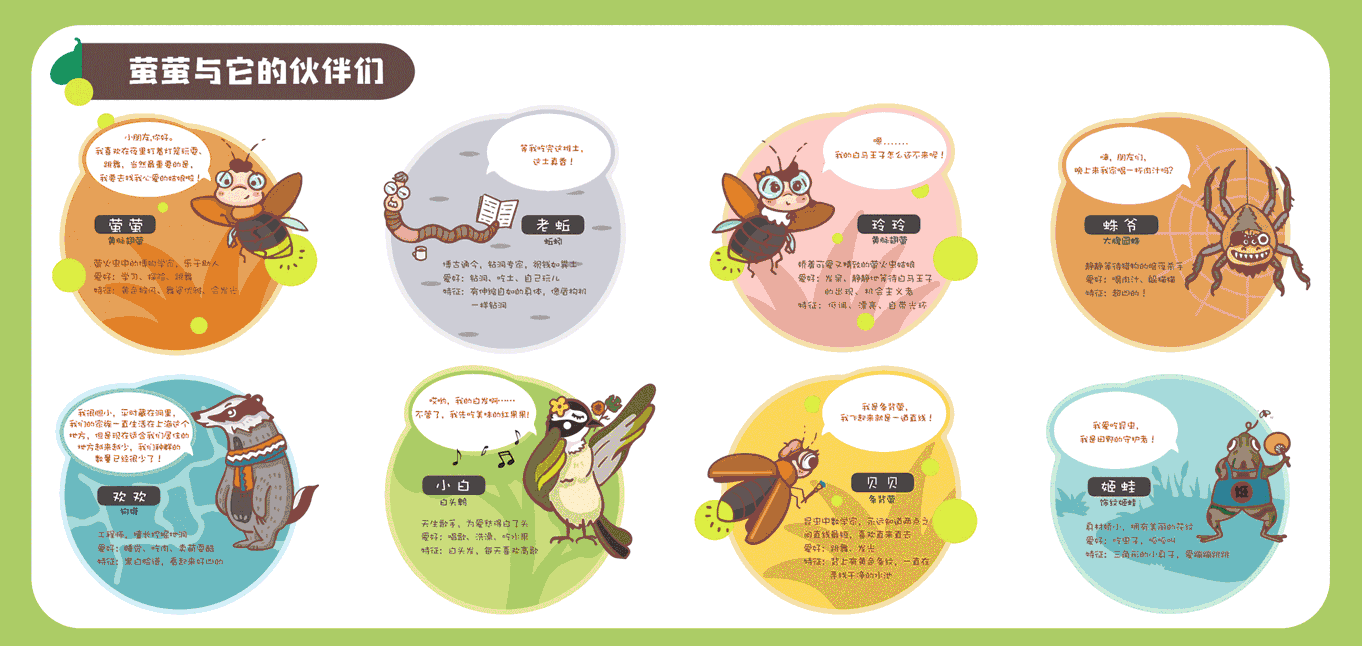
▼科普標(biāo)示——生境手冊
Science signs - habitat manuals
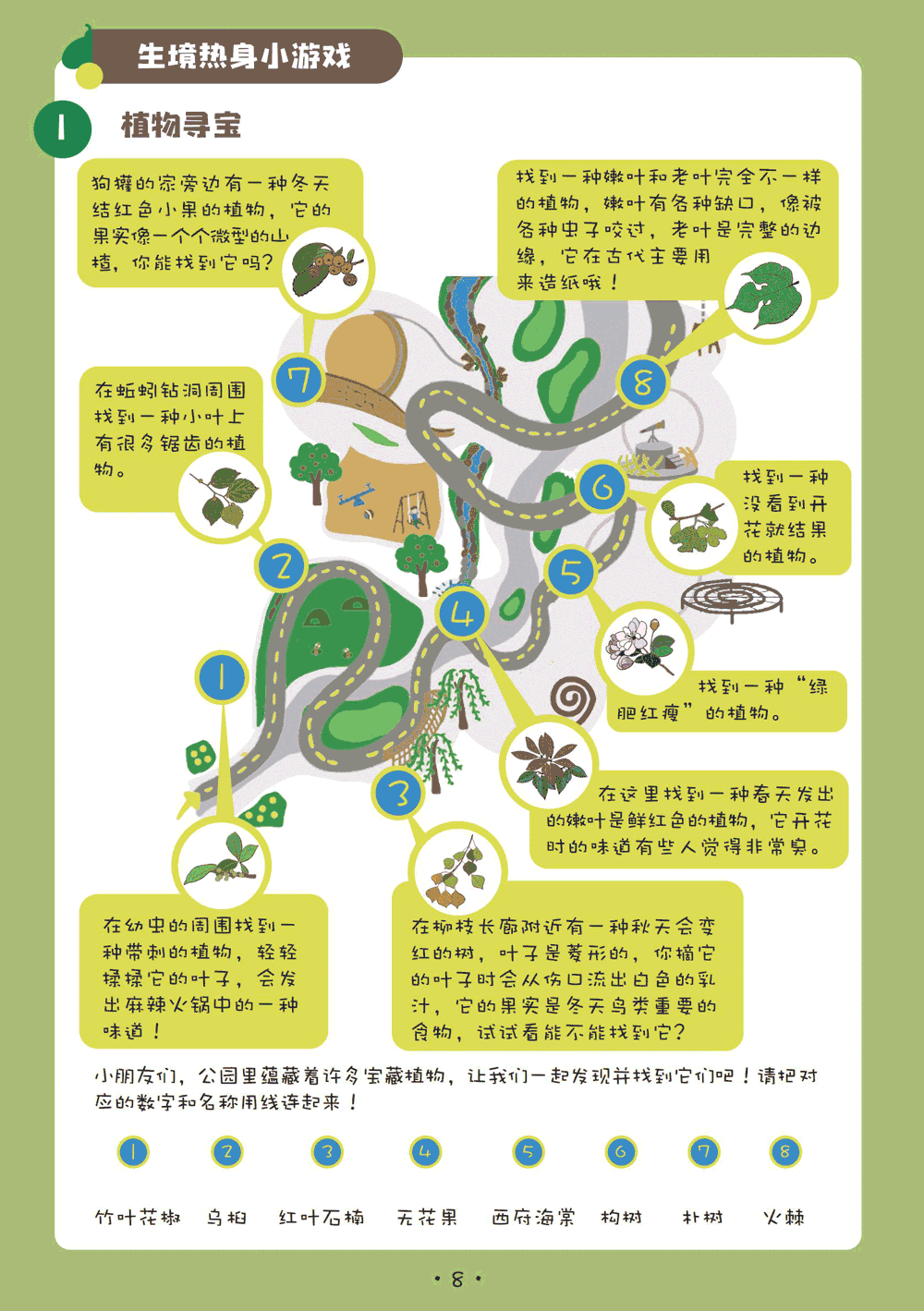
節(jié)點(diǎn)序列
Node sequence
莊行公園依托原有的地形與生態(tài)基底�����,以黃脈翅螢的卵����、幼蟲�、蛹到成蟲的四變態(tài)過程為主線,模仿黃脈翅螢飛行路徑��,串聯(lián)起螢火蟲在生態(tài)環(huán)境里各位“鄰居”們��。
在整體的景觀敘事中��,將自然物種擬人化�����,并提煉其“鄰居”們的生境特征通過空間設(shè)計(jì)轉(zhuǎn)化為有趣�����、互動(dòng)性強(qiáng)的景觀節(jié)點(diǎn)��。
Relying on the original topography and ecological base, Zhuanghang Park takes the four metamorphosis processes from the eggs, larvae, pupae to adults of the yellow-veined firefly as the mainline, imitating the flight path of the yellow-veined firefly, connecting the fireflies in the ecological environment. "Men.
In the overall landscape narrative, natural species are personified, and the habitat characteristics of their "neighbors" are refined into interesting and interactive landscape nodes through space design.
▼生境故事與節(jié)點(diǎn)序列結(jié)合地圖
Habitat story and node sequence combined with map
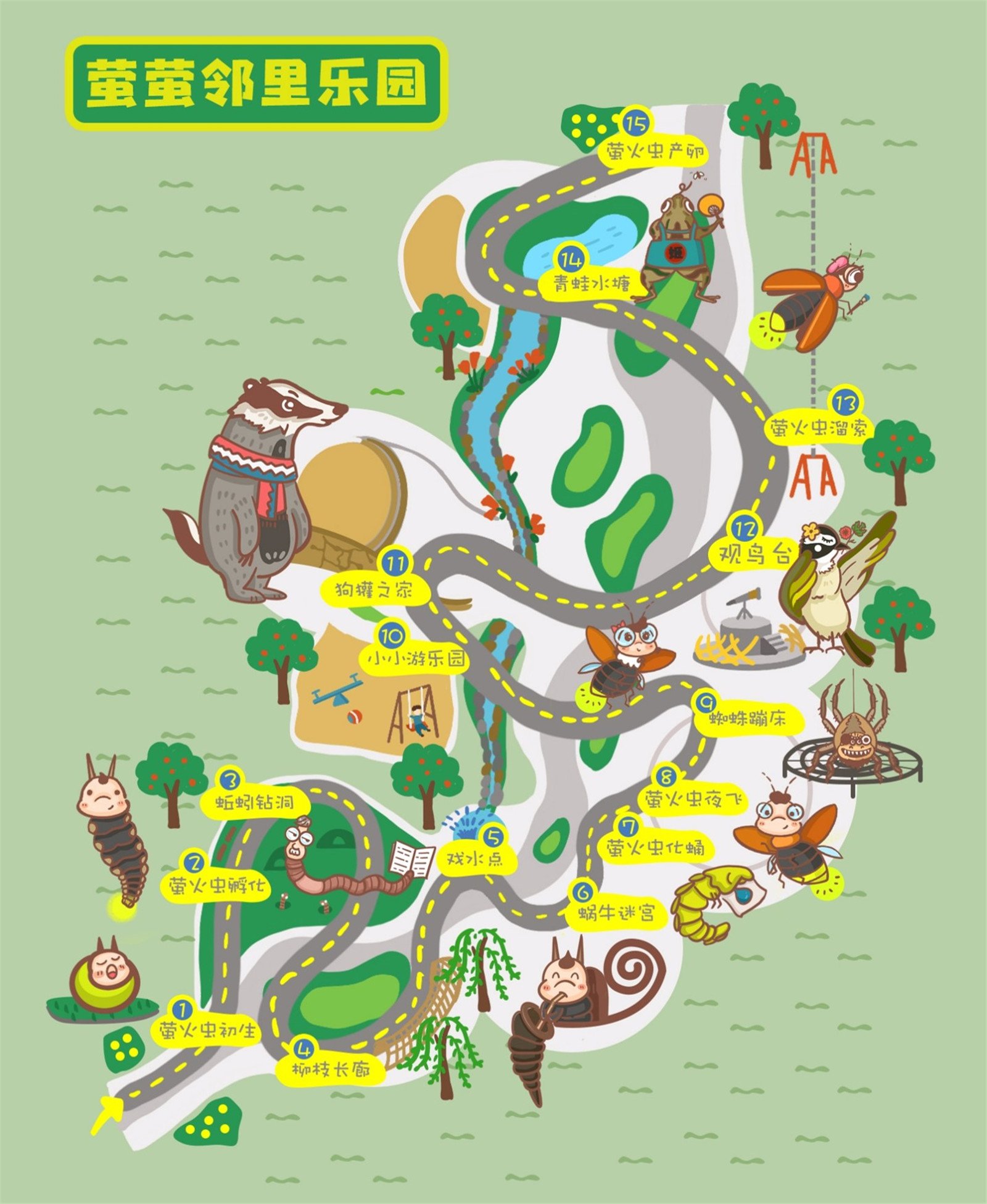
1 螢火蟲初生
The birth of firefly
主人公黃脈翅螢——螢螢出生在潮濕的苔蘚叢中。
用球狀燈與蕨類植物模仿螢火蟲卵在苔蘚叢中的生活環(huán)境�����。
The protagonist——Yingying was born on the moist moss. Bulb lamps and ferns are used to mimic the living environment of firefly eggs in mosses.
▼景觀節(jié)點(diǎn):螢火蟲初生
The birth of firefly ? 劉悅來
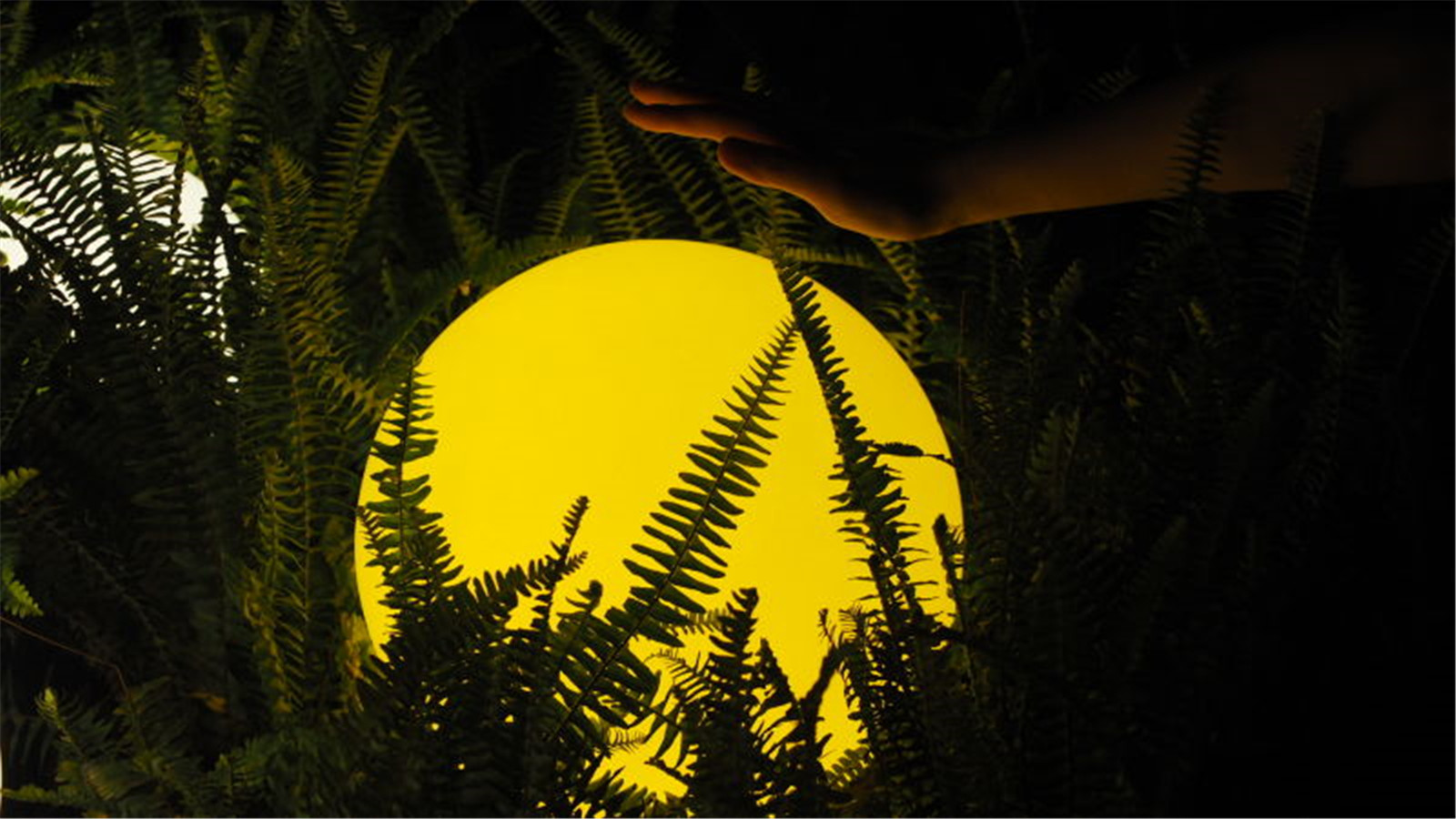
2 蚯蚓
Earthworm
螢螢還是一條幼蟲����,在地面上遇到了探出頭來的蚯蚓爺爺,并陪著他散步����。
蚯蚓鉆洞鼓勵(lì)參與者模仿蚯蚓的動(dòng)作,從而了解蚯蚓是如何在自然界中行走���;
柳枝長廊模擬蚯蚓在泥土中穿過留下的甬道��,在這里科普蚯蚓如何呼吸����、吃土壤中的有機(jī)質(zhì)等信息�����,并鼓勵(lì)參與者觀察真實(shí)的蚯蚓�����。
Yingying, still a baby, meets grandpa earthworm in the soil,and joins him for a walk.The holes encourage people to imitate the moving behavior of earthworms in order to understand how earthworms travel in nature. Willow woven corridor mimics how earthworms travel through existing corridors in earth. People will learn how earthworms breathe, eat organic matters and be encouraged to observe earthworms.
▼景觀節(jié)點(diǎn):蚯蚓的甬道
Earthworm ? 奧沙-亞瑟
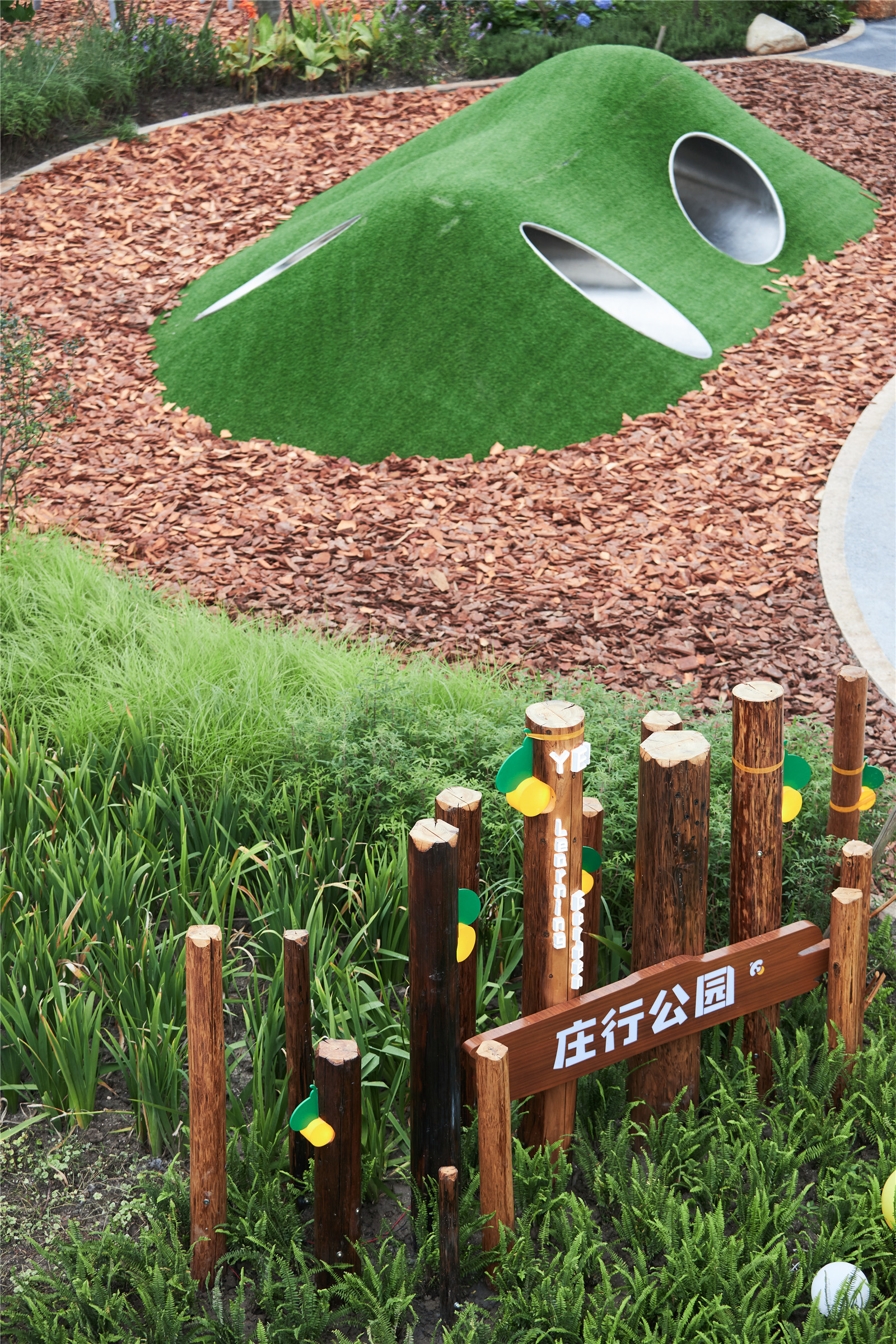
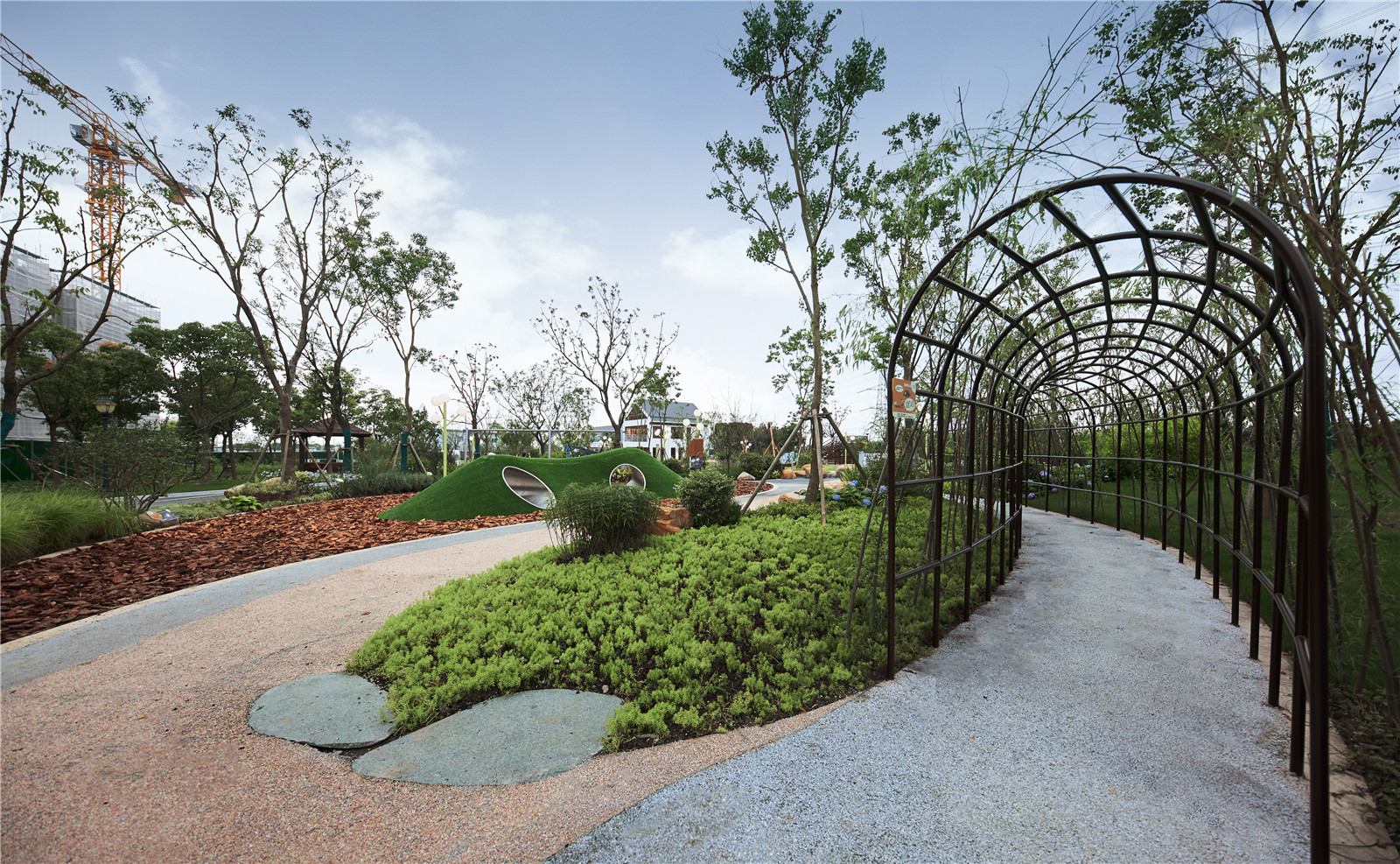
3 蝸牛迷宮
Snail maze
螢螢尋找食物來到了蝸牛迷宮���,這里有他唯一的食物煙管螺����。
請參與者在地面迷宮中行走尋找煙管螺�����,科普黃脈翅螢幼蟲捕食煙管螺時(shí)先將其麻醉���,再注入消化酶使其變?yōu)槿庵钠嫣爻苑ā?/p>
Yingying comes to the snail maze where he will find his only food source the door snails. Visitors are encouraged to walk through the maze to look for snails and learn how Cutos costipennis eat the door snails: he would anesthetize the snail first and inject digestive enzymes to turn the snail into a meat soup.
▼景觀節(jié)點(diǎn):蝸牛迷宮
Snail maze ? 奧沙-亞瑟
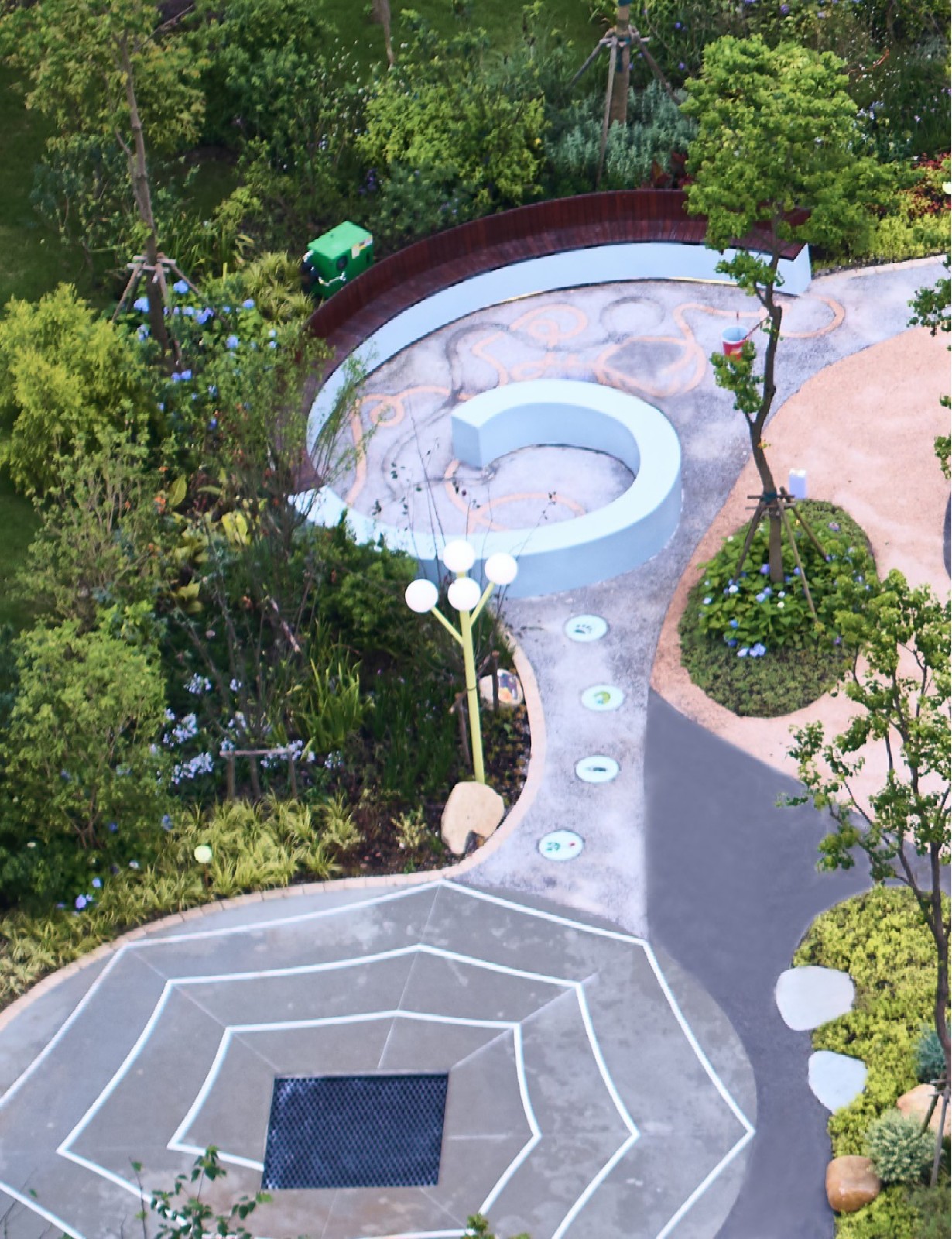
4 蜘蛛蹦床
Spider trampoline
螢螢在羽化后飛行碰到大腹園蛛,嚇得跳了起來��,并機(jī)智地救下了一位同伴玲玲�����。
蜘蛛蹦床用跳的方式提醒參與者大腹園蛛是黃脈翅螢的天敵���,并且科普螢火蟲在遇到危險(xiǎn)時(shí)也會(huì)發(fā)光��,還會(huì)釋放氣味��。
After Yingying gets his wings, he runs into the orb-weaving spiders where he jumps up in fright but tactfully saves a friend Lingling. The act of jumping reminds participants that the spider is the enemy of the firefly, and that fireflies also emit light and smell when in danger.
▼景觀節(jié)點(diǎn):蜘蛛蹦床
Spider trampoline ? 奧沙-亞瑟
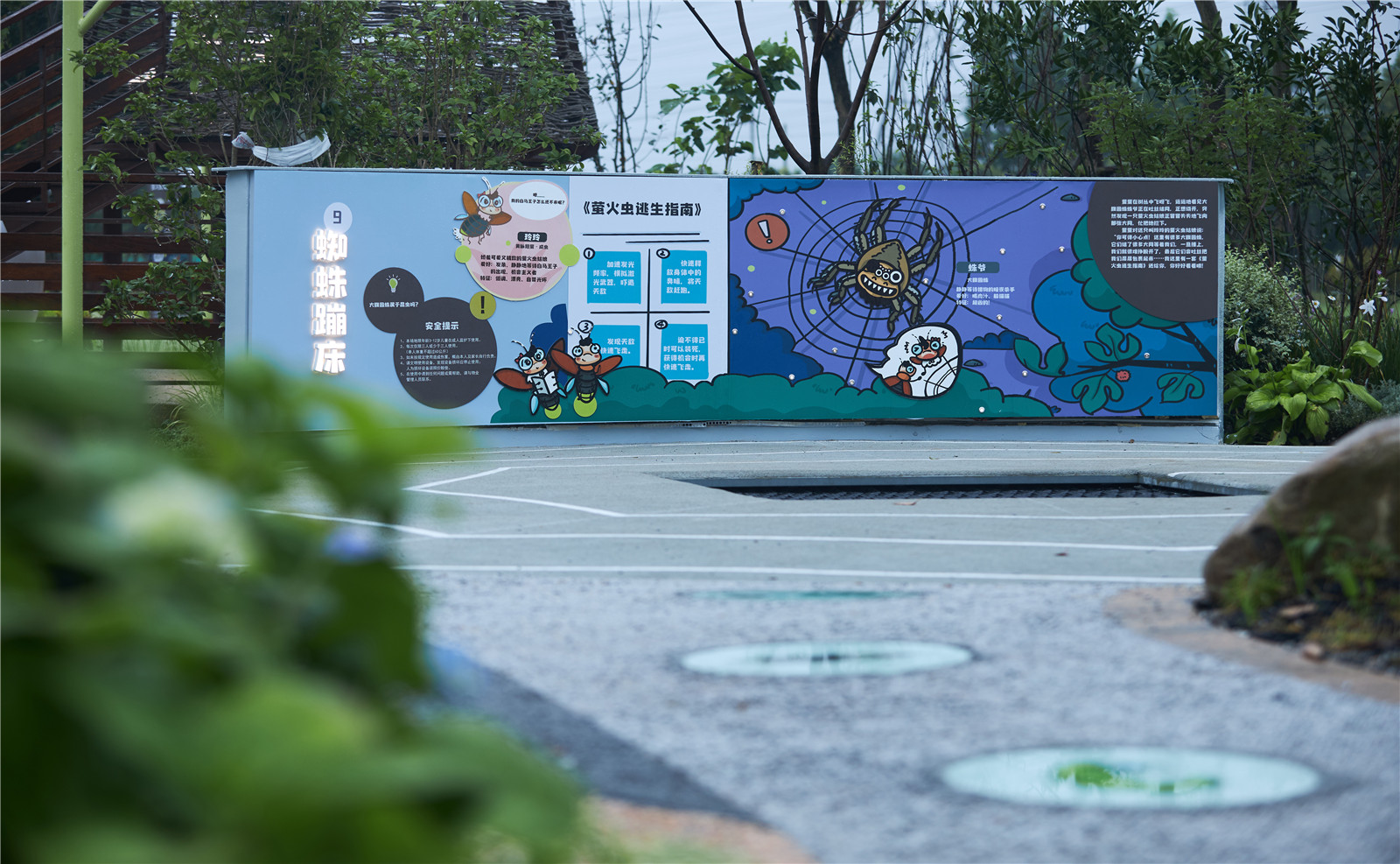
5 狗獾之家(小小游樂場)
Badger’s House(Little Amusement Park)
螢螢與玲玲夜飛����,遇到了同樣夜晚尋找食物的狗獾哥哥,并一起參觀了它的家���。
在小小游樂場為3-12歲的低齡兒童設(shè)計(jì)����,其中墻面模擬了狗獾洞穴的分布����,地面上鑲嵌了1:1比例大小的狗獾腳印,小朋友們可以沿著狗獾的腳步找到它的家�����,用滑軌認(rèn)識(shí)狗獾的家中廁所��、臥室等分布�����。
Yingying and Lingling fly at night when they meet brother badger who is looking for food. They visited his home later.
Little Amusement Park is designed for children aged 3-12. The wall mimics the distribution of badgers' cave, and the ground is inlaid with 1:1 proportion of badgers' footprints. Children can find the home along the badgers' footsteps and know the distribution of badgers' toilets and bedrooms with the slide track.
▼景觀節(jié)點(diǎn):狗獾之家
Badger’s House ? 奧沙-亞瑟
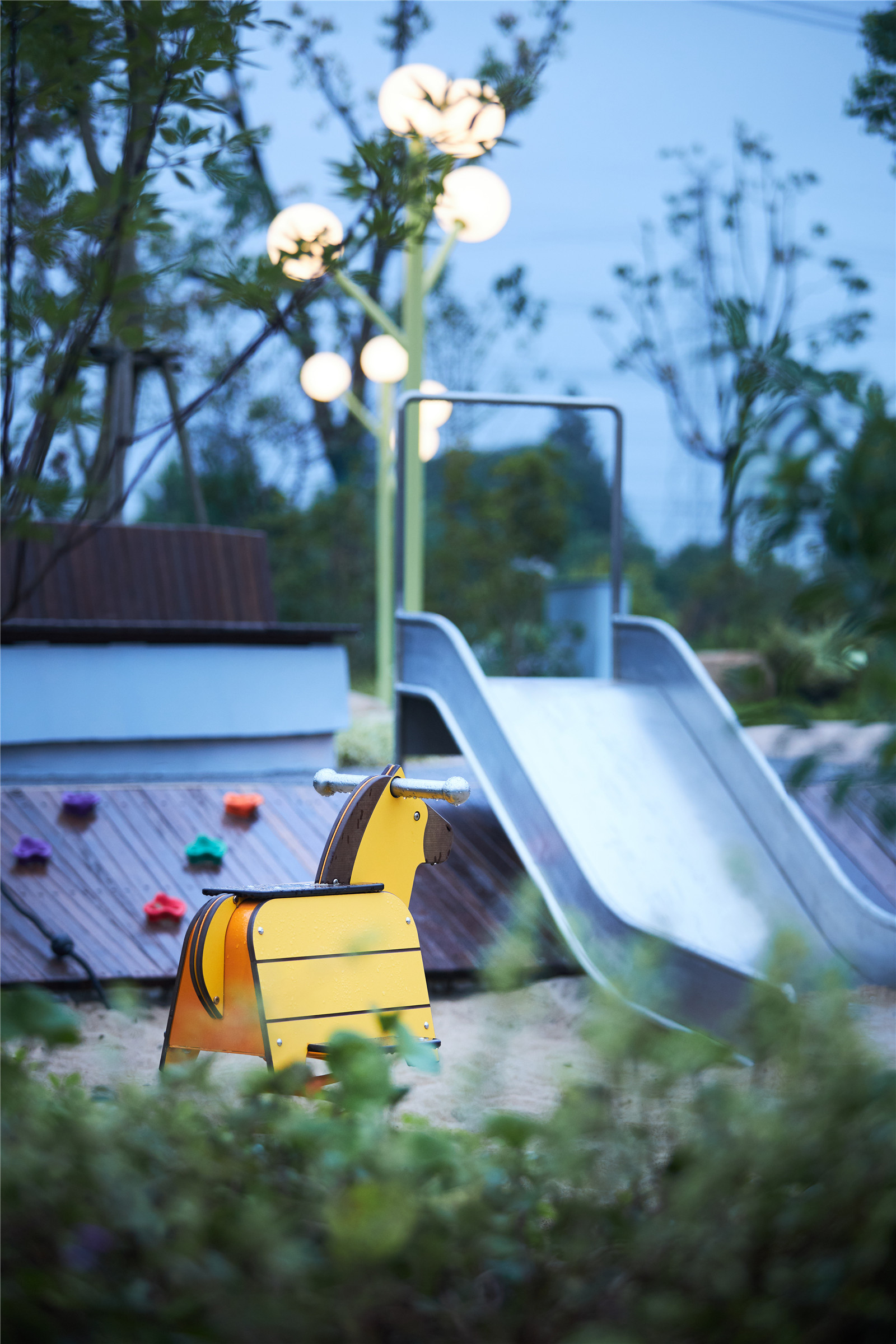
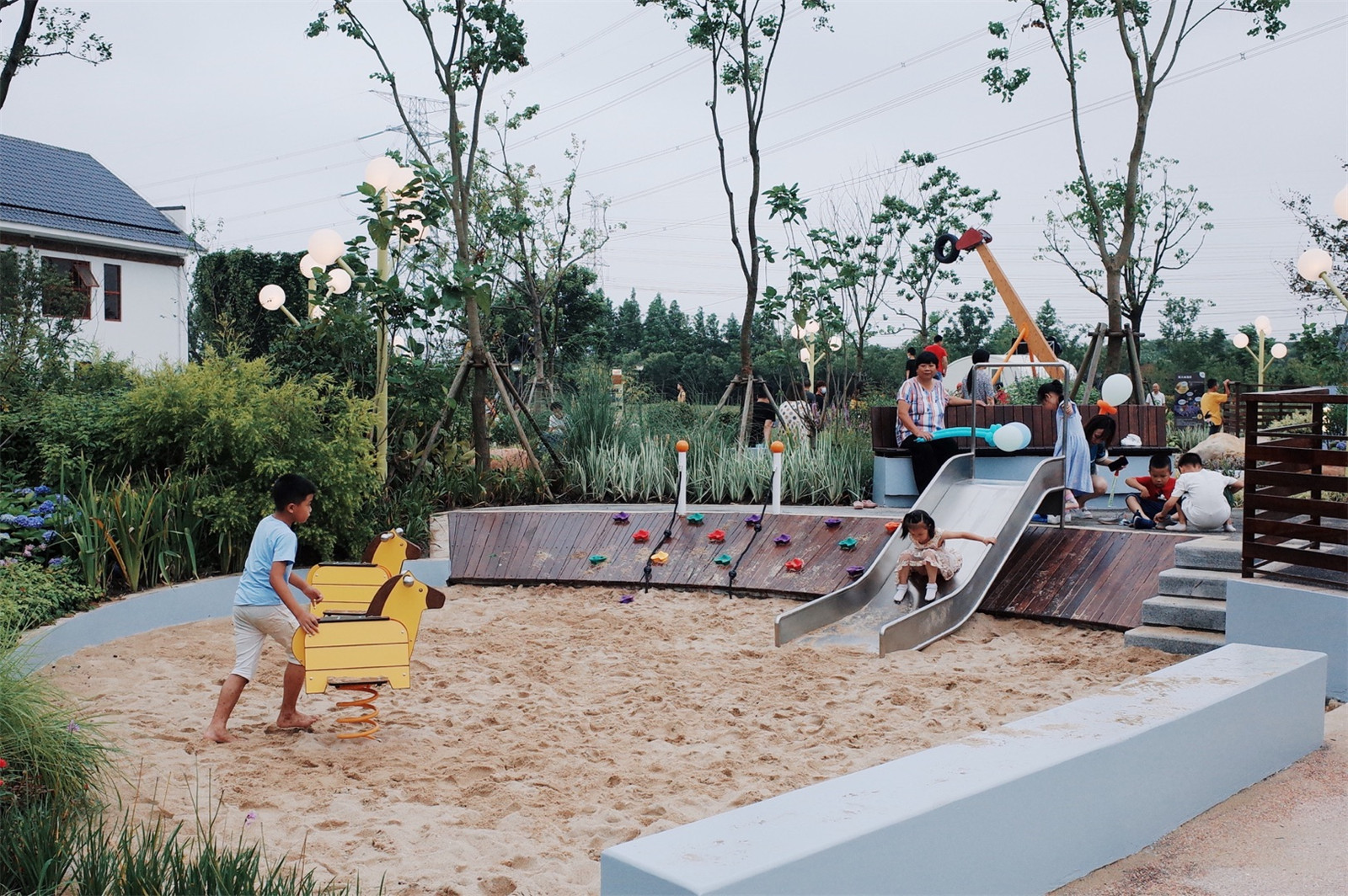
6 觀鳥臺(tái)
Bird watching
螢螢和玲玲跟著狗獾哥哥一同尋找構(gòu)樹的果子,發(fā)現(xiàn)在構(gòu)樹枝上睡覺的白頭鵯����。
觀鳥臺(tái)上有望遠(yuǎn)鏡可以觀察鳥類,這里以互動(dòng)標(biāo)識(shí)牌的形式科普上海其他常見鳥類�����,提醒大家觀鳥注意事項(xiàng)���。
Yingying and Ling Ling follow their badger brother to search for fruit in the Broussonetia papyrifera and find the light-vented bulbul is taking a nap. There are binoculars on the bird watching platform and people will learn about other common birds in Shanghai through interactive signs where instructions for birth watching are shown as well.
▼觀鳥臺(tái)
Bird watching? 嚴(yán)建雯
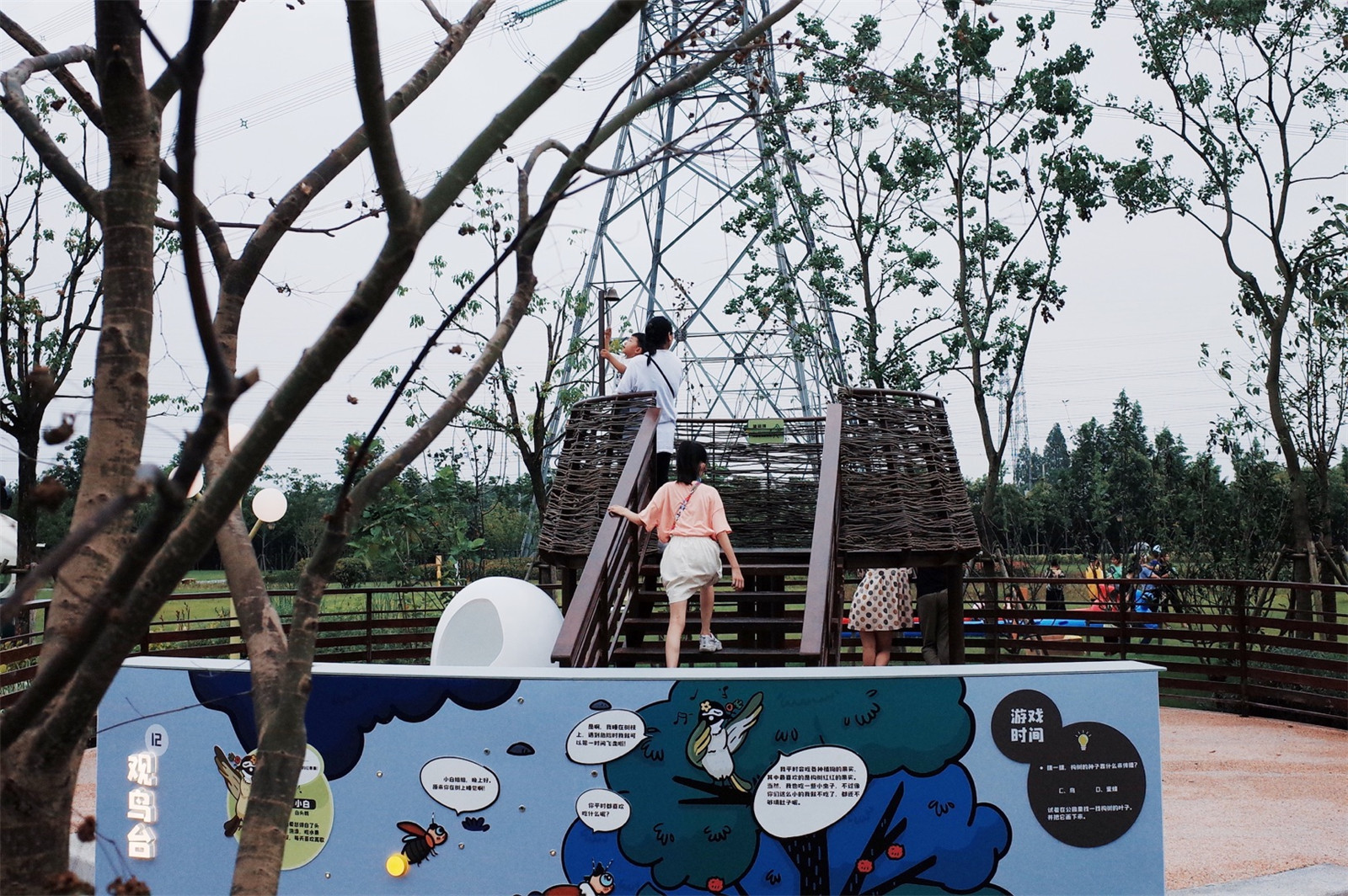
7 螢火蟲溜索
Firefly zip line
螢螢與玲玲飛到水邊,碰到了他們在上海的另外一位親戚——條背螢��。
條背螢是飛行路徑是直線的一種水生螢火蟲��,通過溜索讓參與者體會(huì)條背螢飛行的感覺�。
Yingying and Lingling fly to the water's edge where they meet another relative in Shanghai, Luciola substriata.Luciola substriata are aquatic fireflies whose flight path is a straight line. Through the zip line, people will learn how this firefly flies.
▼景觀節(jié)點(diǎn):螢火蟲溜索
Firefly zip line ? 奧沙-亞瑟
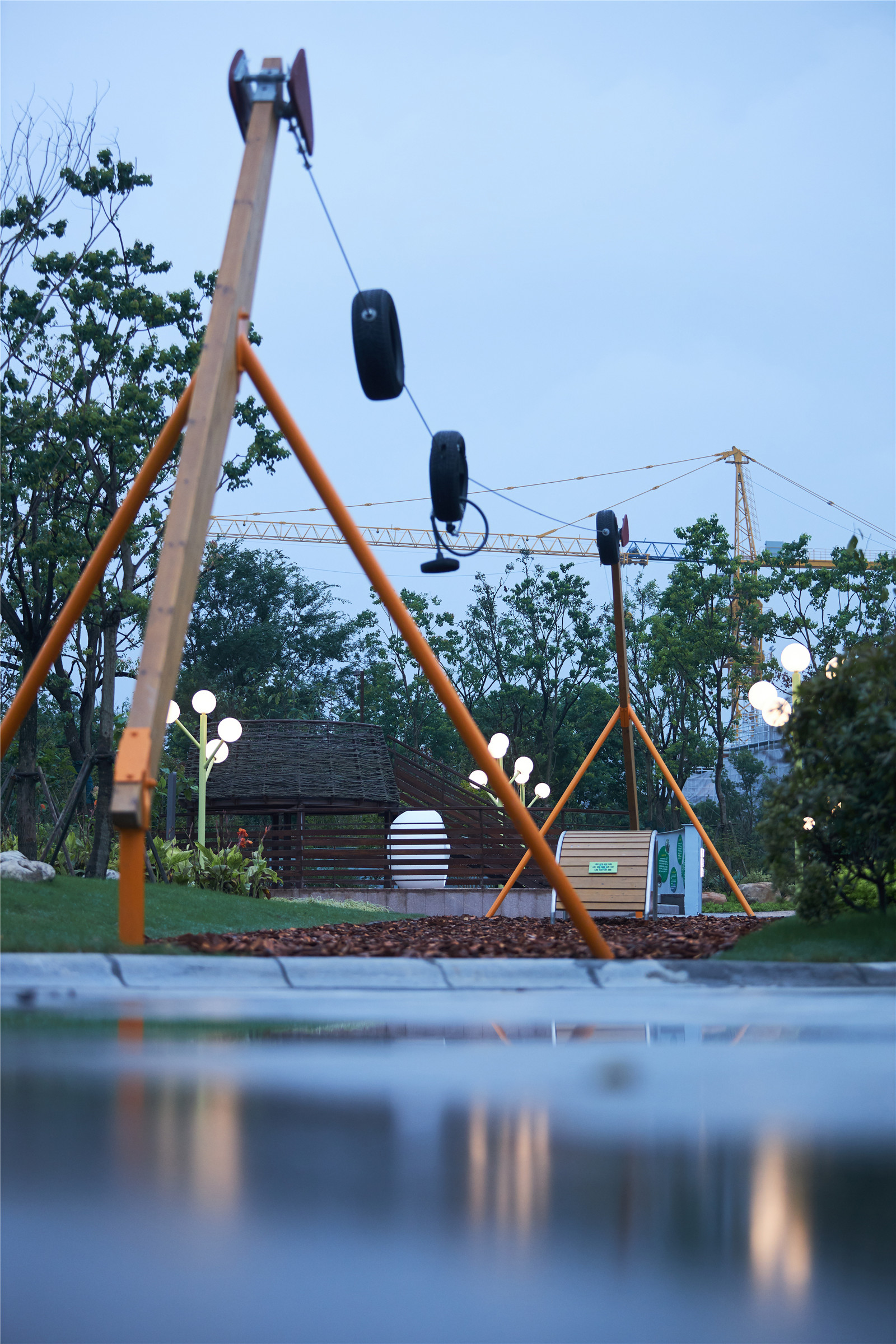
8青蛙水池
Frog pond
這里是螢螢與玲玲旅行遇到的最后一位鄰居——飾紋姬蛙
設(shè)計(jì)中延伸介紹了水在自然界中的重要性,通過霧森���、旱溪���、的手法表現(xiàn)水在自然界中不同的存在方式。青蛙水池中配置了豐富的沉水�、浮水�、挺水植物�,希望吸引更多種類的蛙類來這里棲息。
This is the last neighbor Yingying and Lingling encounter. The importance of water in nature is introduced in the design, and different forms of water are presented through fog, dry creek and other design techniques. The frog pond is equipped with abundant submerged, floating and emergent plants, hoping to attract more species of frogs to inhabit here.
▼青蛙水池
Frog pond ? 奧沙-亞瑟
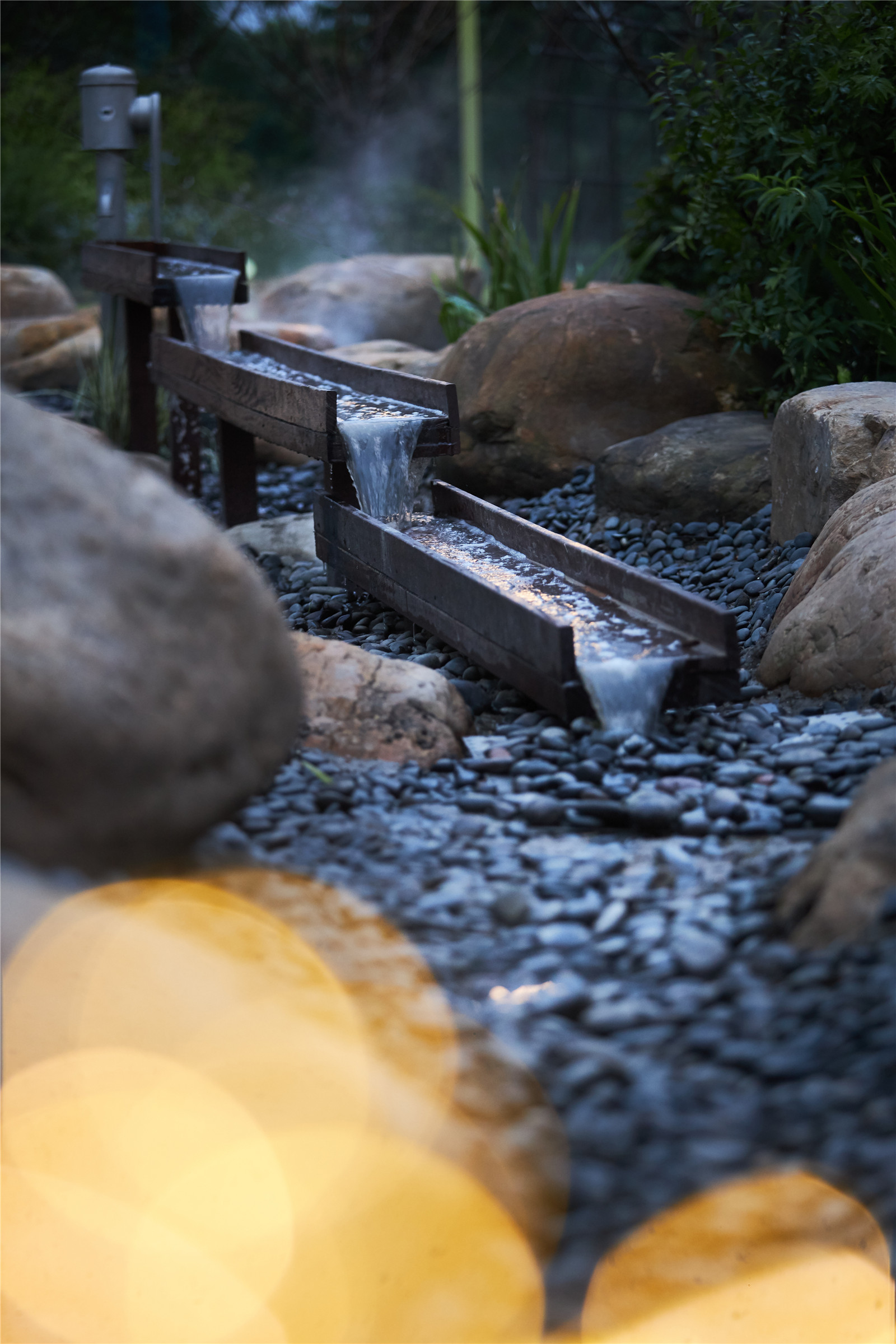
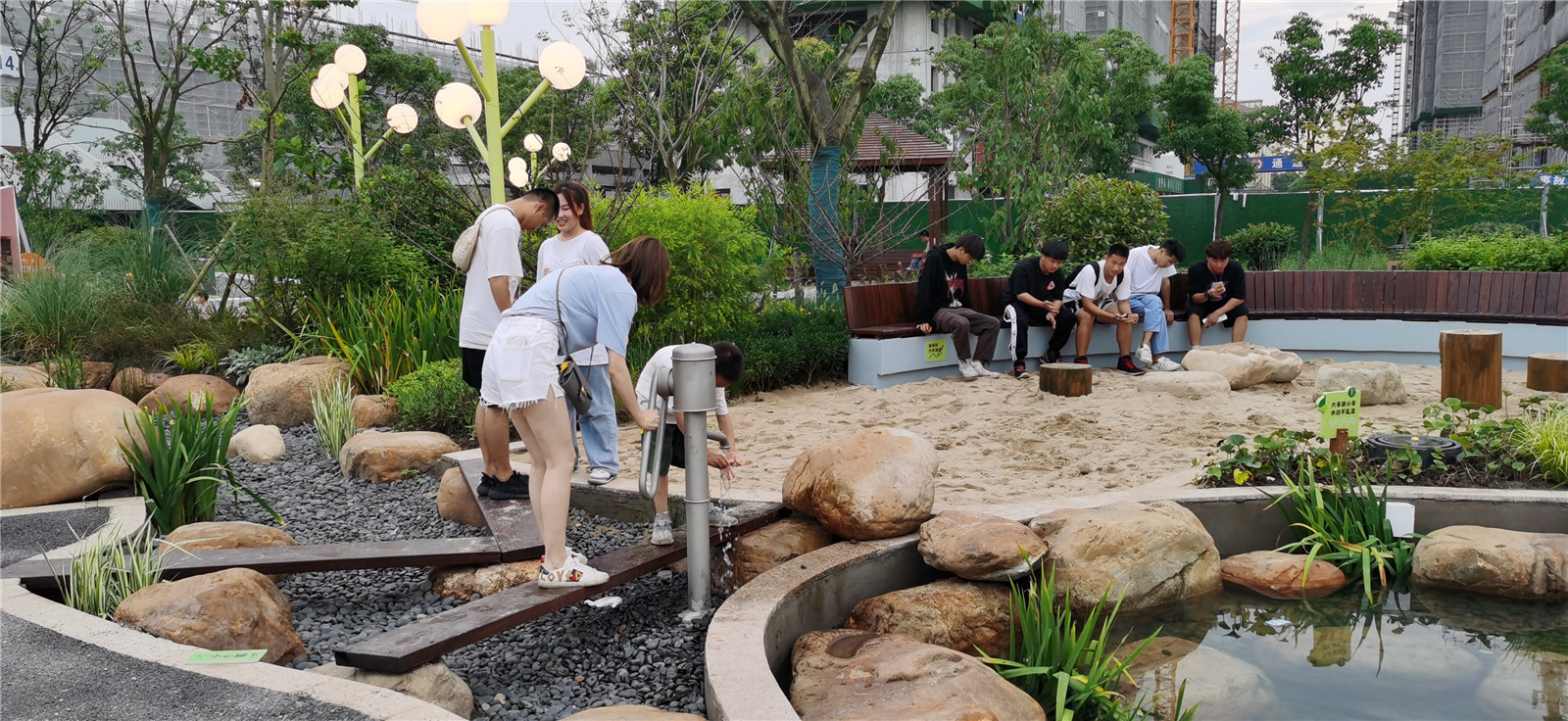
9 螢火蟲產(chǎn)卵
Firefly pupa
螢螢與玲玲在一片干凈潮濕的苔蘚地中產(chǎn)下了屬于它們的后代���,就安靜地結(jié)束了一生����。
希望黃脈翅螢?zāi)茉谶@片土地中生生不息�,與它的鄰居們也包括人類能友好共存。
Yingying and Lingling give birth on a clean and moist moss and thus peacefully retire from life.The hope is that the fireflies will thrive in this land and coexist with its neighbors, including humans.
▼螢火蟲產(chǎn)卵
Firefly pupa ? 奧沙-亞瑟
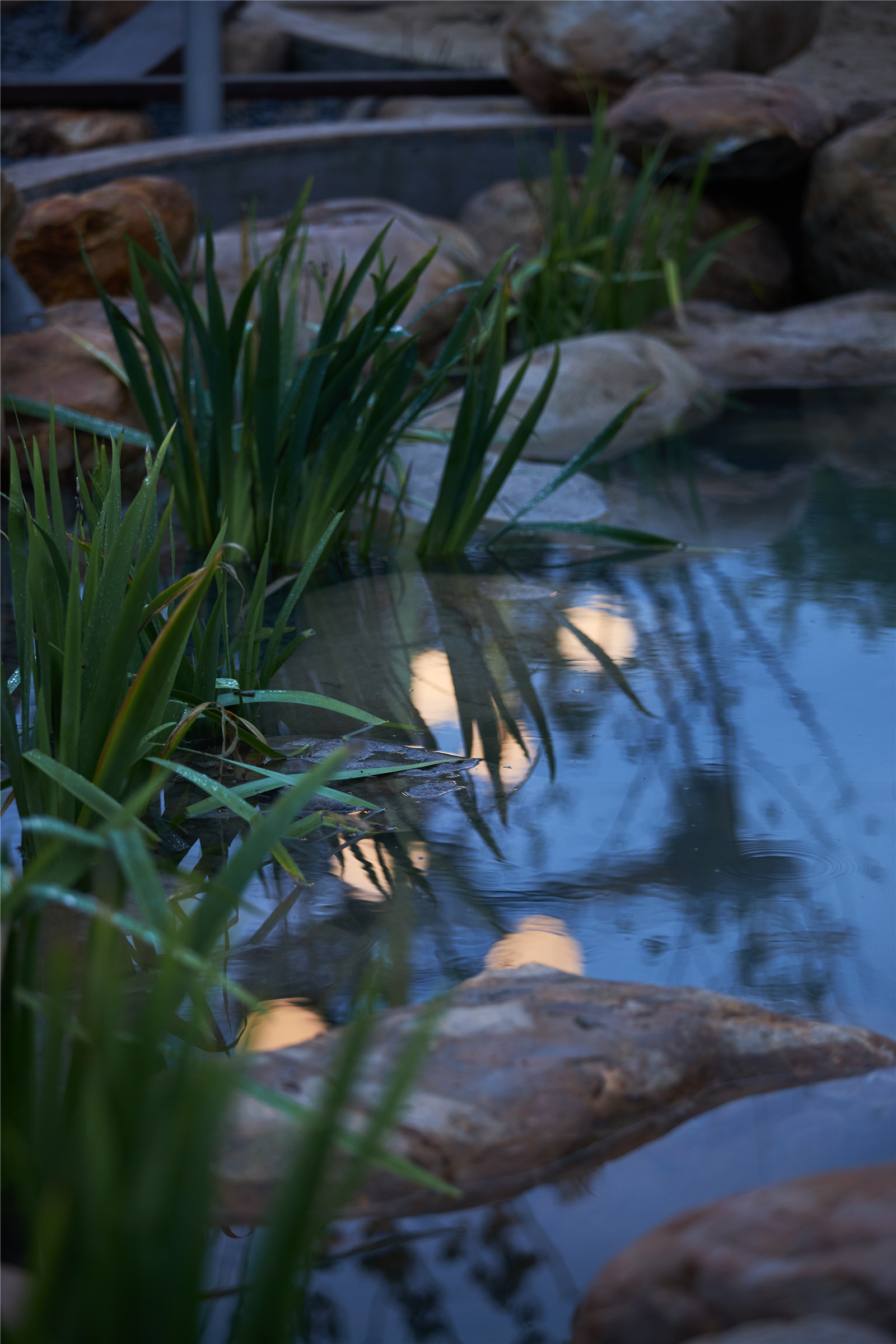
為老設(shè)計(jì)/康養(yǎng)療愈
Healing garden and Allotment garden
在社區(qū)花園中特別設(shè)計(jì)都市菜園與療愈花園��。
菜園通過在地育苗�����、種植����、收獲、堆肥�����,讓能量循環(huán)可持續(xù),同時(shí)融入中國傳統(tǒng)的二十四節(jié)氣指導(dǎo)種植���,注入文化內(nèi)涵�����。 這樣的“共享菜園”在社區(qū)營造中起到重要作用�����,為周邊老人及兒童提供種植��、互動(dòng)的空間���。
療愈花園通過感官環(huán)境設(shè)計(jì)讓自然界蟲鳴鳥叫,植物與水的特性刺激人體五感(視覺��,聽覺�,嗅覺��,觸覺�,味覺),達(dá)到緩解壓力���,安撫情緒�,恢復(fù)精神的作用。
The allotment garden and the healing garden are specially designed. By cultivating seeds, planting, harvesting and composting, the materials and energy are recycled. The traditional Chinese 24 solar terms are used to guide the planting. This shared garden is very important in community building and provides space for growing and interactions especially for the local elderly and children. The healing garden stimulates our five senses (sight, sound, touch, smell and taste) through a sensory environment with insects, birds, plants and water. The interactions will help people to relieve stress, soothe emotions and restore energy.
▼為老設(shè)計(jì)
Healing garden ? 奧沙-亞瑟/嚴(yán)建雯
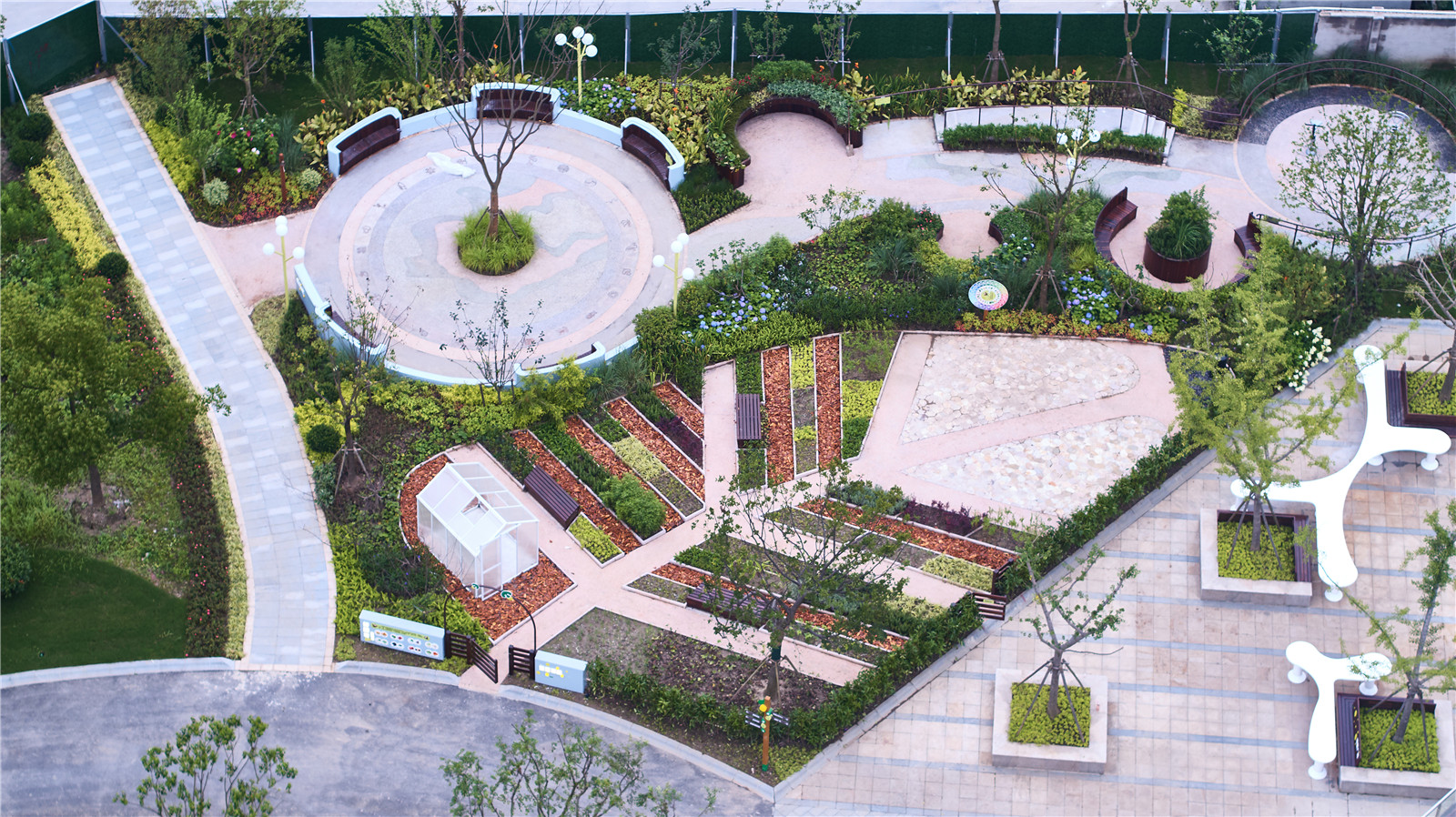
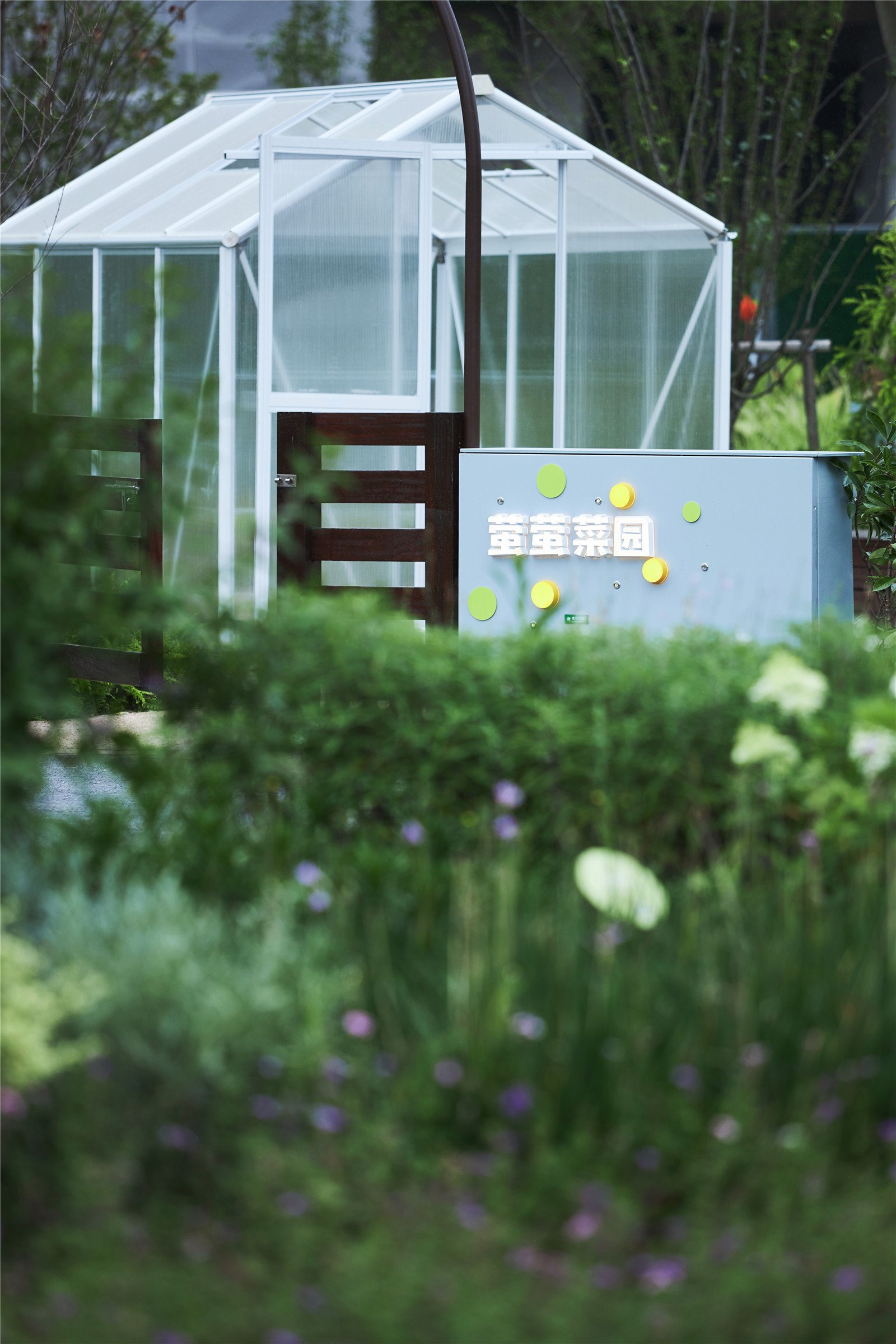
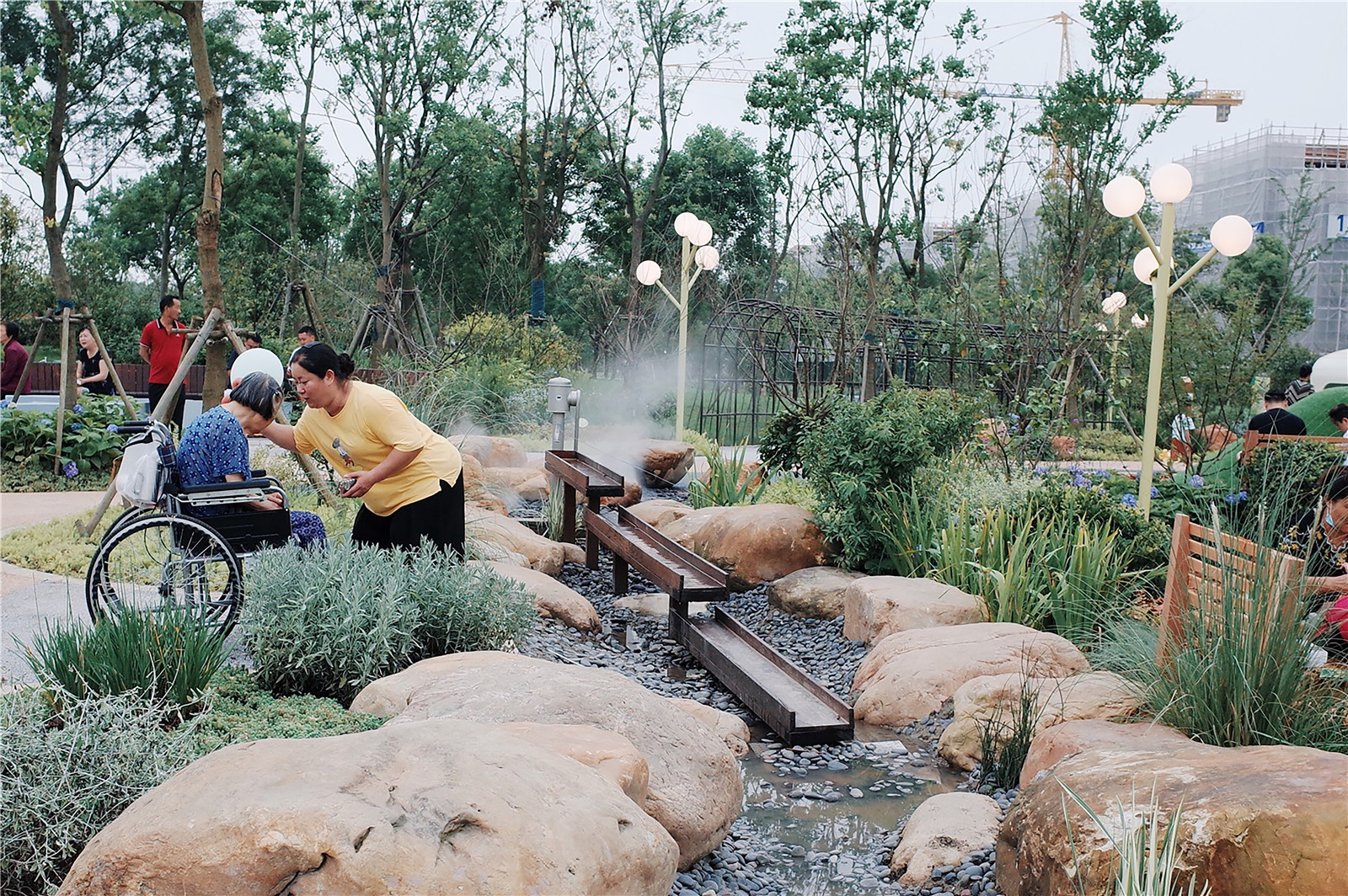
設(shè)計(jì)亮點(diǎn)
Design highlights
我們景觀設(shè)計(jì)的目標(biāo)是在為人們創(chuàng)建一個(gè)舒適的休閑基礎(chǔ)設(shè)施的同時(shí)��,為這里的動(dòng)物棲居與生態(tài)環(huán)境作出一定的貢獻(xiàn)����。為盡量減少對環(huán)境的影響,我們在項(xiàng)目中采用了許多特殊技術(shù)和設(shè)計(jì)方案���,比如:場地硬質(zhì)全部嚴(yán)格使用透水混凝土����;游樂區(qū)緩沖墊層用環(huán)保材料樹皮�����;場地中旱溪部分參考雨水花園做法����;部分坐凳結(jié)合了昆蟲箱做法。
在目前景觀做法中��,游樂區(qū)緩沖墊層采用樹皮的做法并不常見���,所以在項(xiàng)目實(shí)施過程中��,施工隊(duì)對于游戲緩沖墊層的做法有爭議�,并將底層結(jié)構(gòu)做成了混凝土,在設(shè)計(jì)師努力爭取下返工改為透水做法?��,F(xiàn)在整個(gè)設(shè)計(jì)區(qū)域都是可透水的工程做法�����,在上海7月份汛期很有效果�。
The material used are considered for their eco-friendly qualities:the hardscape with pervious concrete, the play area cushion and buffer layer uses tree bark, the dry creek area behaving like a rain garden and some seats with insect boxes embedded. It is not very common to use tree barks for the buffer area in playground thus there were disagreements between designers and the construction team. After a thorough discussion, the designers convinced the construction team to turn the base layer into concrete with permeable qualities. The whole designed area is permeable which Is very effective during Shanghai’s June and July rain seasons.
▼游樂區(qū)樹皮緩沖墊層
The play area cushion and buffer layer uses tree bark ? 奧沙-亞瑟
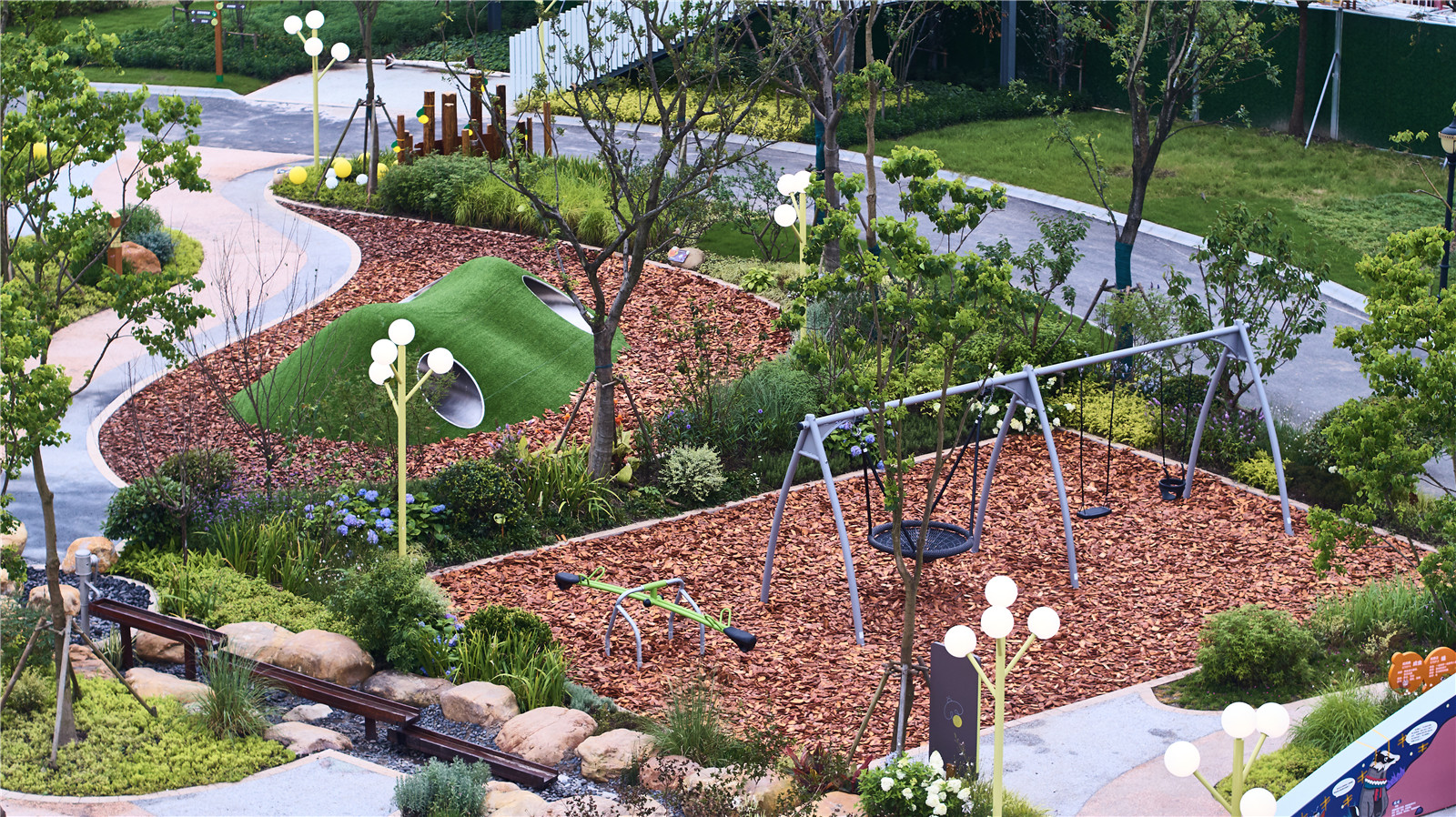
設(shè)計(jì)內(nèi)容中還策劃了12各月份不同主題的活動(dòng)���,今年7月我們迎來了螢火蟲社區(qū)花園開幕式&文化節(jié)����。莊行社區(qū)花園開幕當(dāng)天�����,現(xiàn)場有年輕的父母帶著孩子����,老人、青年人結(jié)伴而來����,設(shè)計(jì)師在現(xiàn)場看到許多笑臉也聽到許多贊賞非常感動(dòng)。開幕式當(dāng)天吸引眾多自然教育機(jī)構(gòu)與商業(yè)機(jī)構(gòu)來現(xiàn)場做活動(dòng)����,根據(jù)活動(dòng)類型與受歡迎程度可篩選機(jī)構(gòu)作為常駐社區(qū)花園的活動(dòng)組織方,并在后續(xù)社區(qū)組織的幫助下培育志愿者���,在當(dāng)?shù)卦黾庸ぷ鳈C(jī)會(huì)��,成為在地力量促進(jìn)可持續(xù)發(fā)展����。
The design content also planned activities of different themes in December. In July this year, we ushered in the opening ceremony & cultural festival of the Firefly Community Garden. On the opening day of the community garden, there were young parents with their children, grandparents with their family and friends coming together. The designers were very touched to see many smiling faces and hear many positive feedbacks.The opening day attracted many local institutions and businesses. They will further be selected based on the activities they provide and their popularity to be long term partners with the garden. They will also help with training volunteers with the guidance of the community organizer to increase work opportunities locally and become the local force for a sustainable future.
▼兒童在水池邊嬉戲
Children playing by the pool ? 拾柒
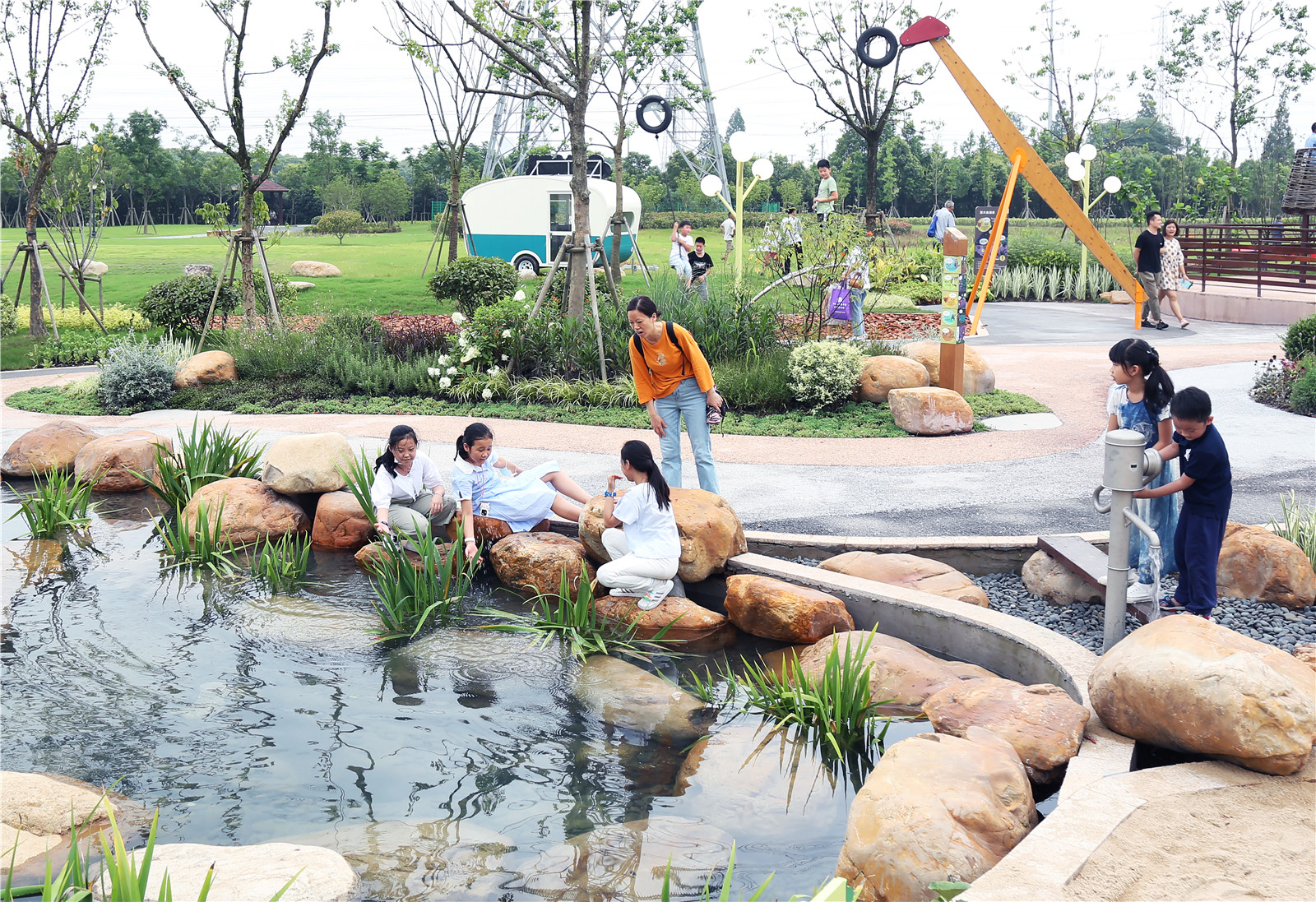
▼七月份開園活動(dòng)
Opening of the park in July ? 拾柒
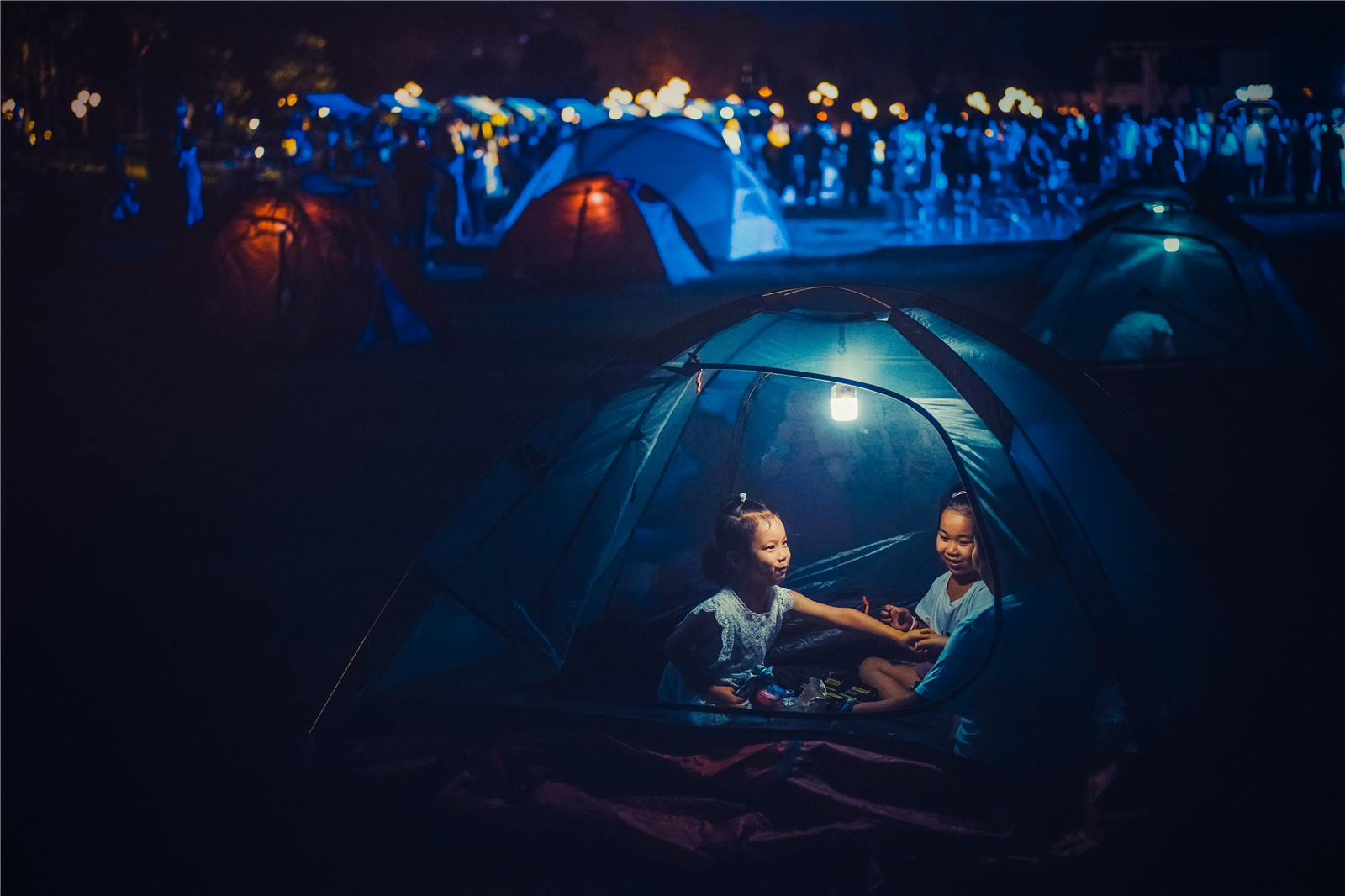
一直以來�,我們都在為了共建人與自然共處的美麗家園而努力著,在追求這個(gè)簡單樸實(shí)的夢想的道路上�����,作為設(shè)計(jì)師�����,作為社區(qū)規(guī)劃師,作為社區(qū)活動(dòng)策劃者���、參與者��,我們有時(shí)備受鼓舞����,有時(shí)遭遇阻礙��,更多的時(shí)候默默無聞�、勤勤懇懇。但是同每一次項(xiàng)目落成時(shí)一樣�,當(dāng)我們再次來到建成后的莊行公園,聽到水塘中澤蛙的鳴叫���,看到孩子們追逐昆蟲的笑臉���,暢想著未來螢火蟲們的到來,我們似乎又獲得了某種力量��,足以支撐我們前進(jìn)��。
We have always been working hard to build a beautiful home where man and nature coexist. As designers, as community planners, as community event planners and participants, we are pursuing this sincere dream. Sometimes inspired, sometimes hindered, and more often unknown and diligent. But like every time the project was Built, when we came to the Zhanghang Park after it built, we heard the croaking of frogs in the pond, saw the smiling faces of children chasing insects, and imagined the coming of fireflies in the future. We have gained some strength, enough to support us forward.
▼標(biāo)識(shí)設(shè)計(jì)
Signage design ? 奧沙-亞瑟/嚴(yán)建雯
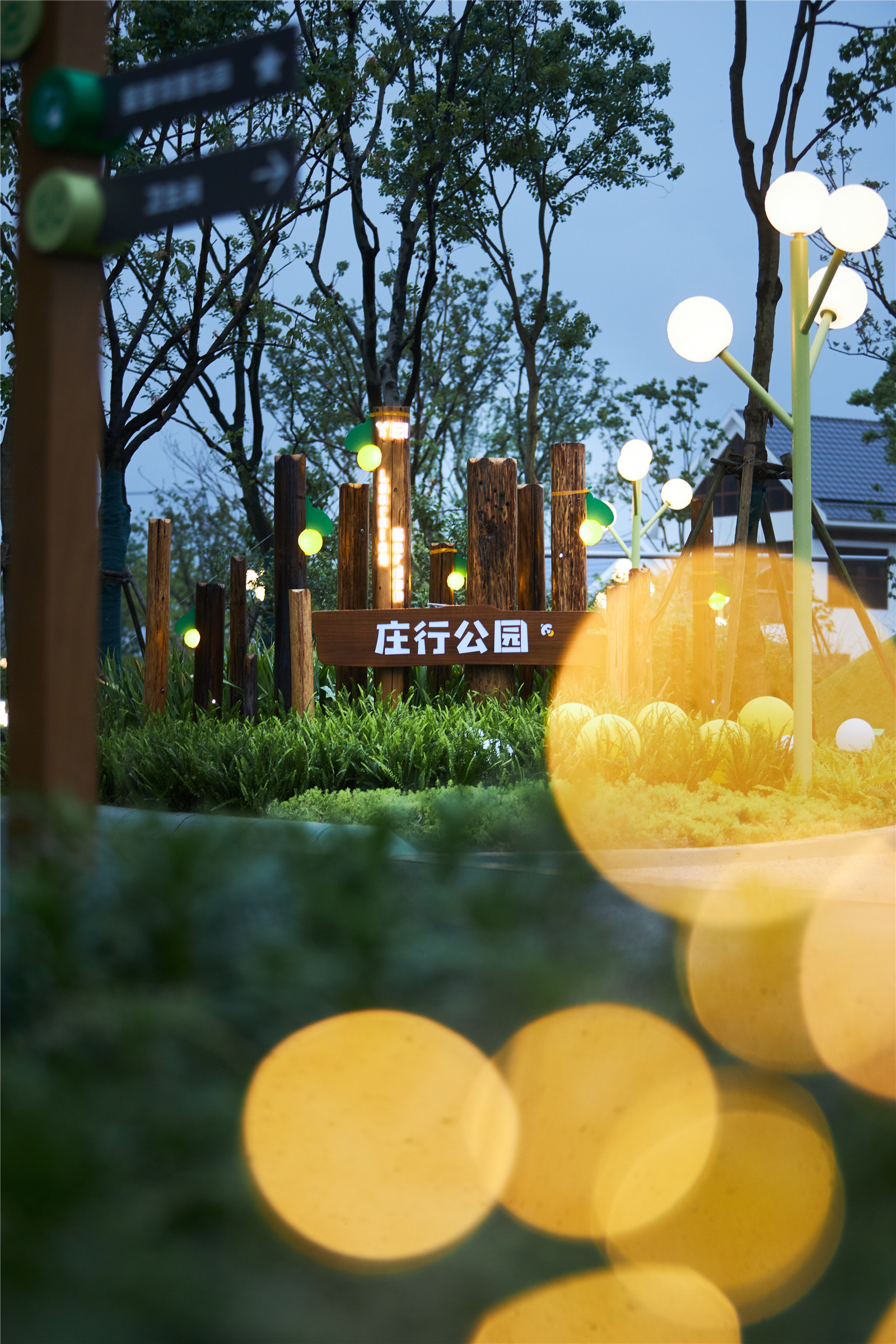
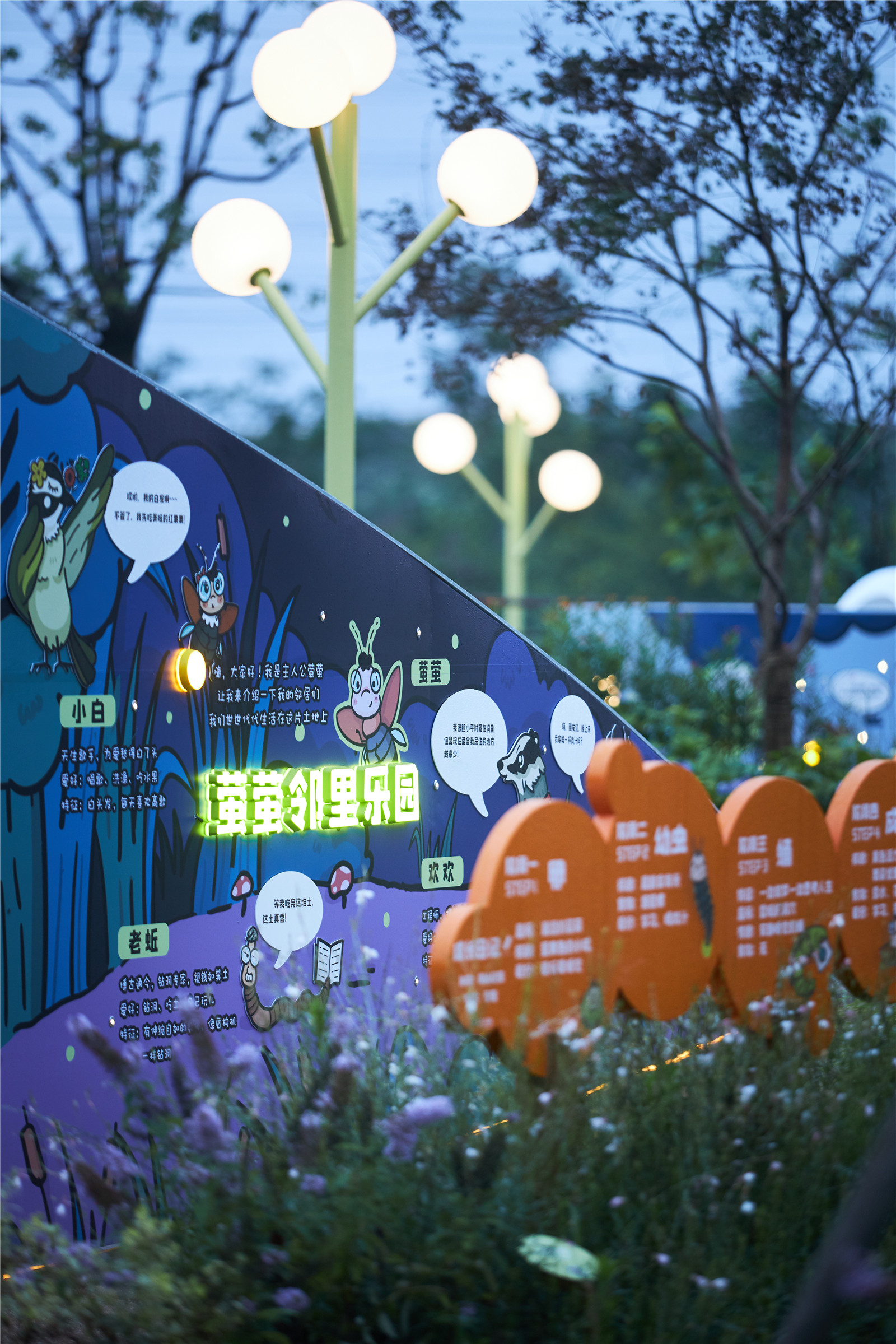
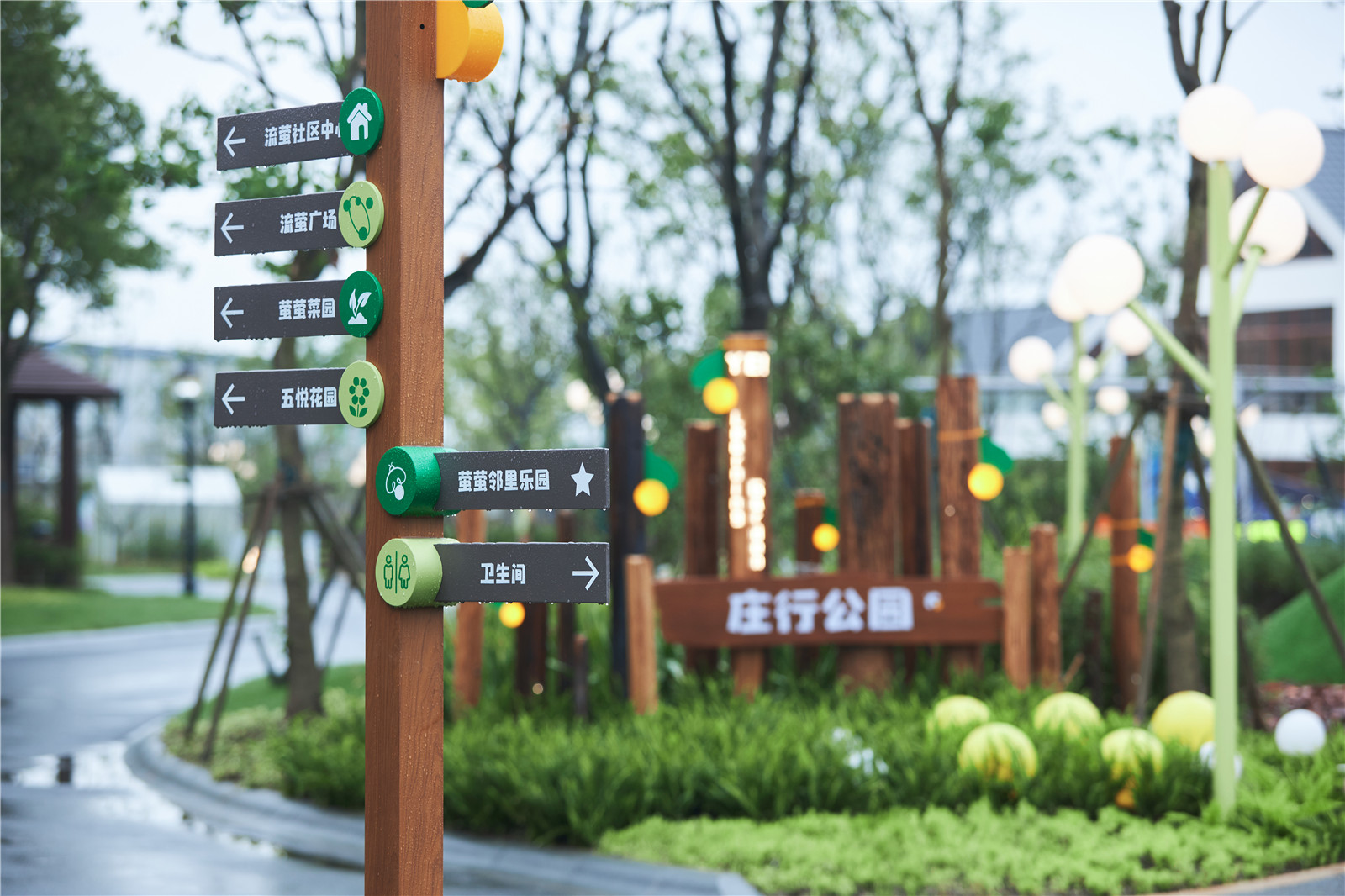
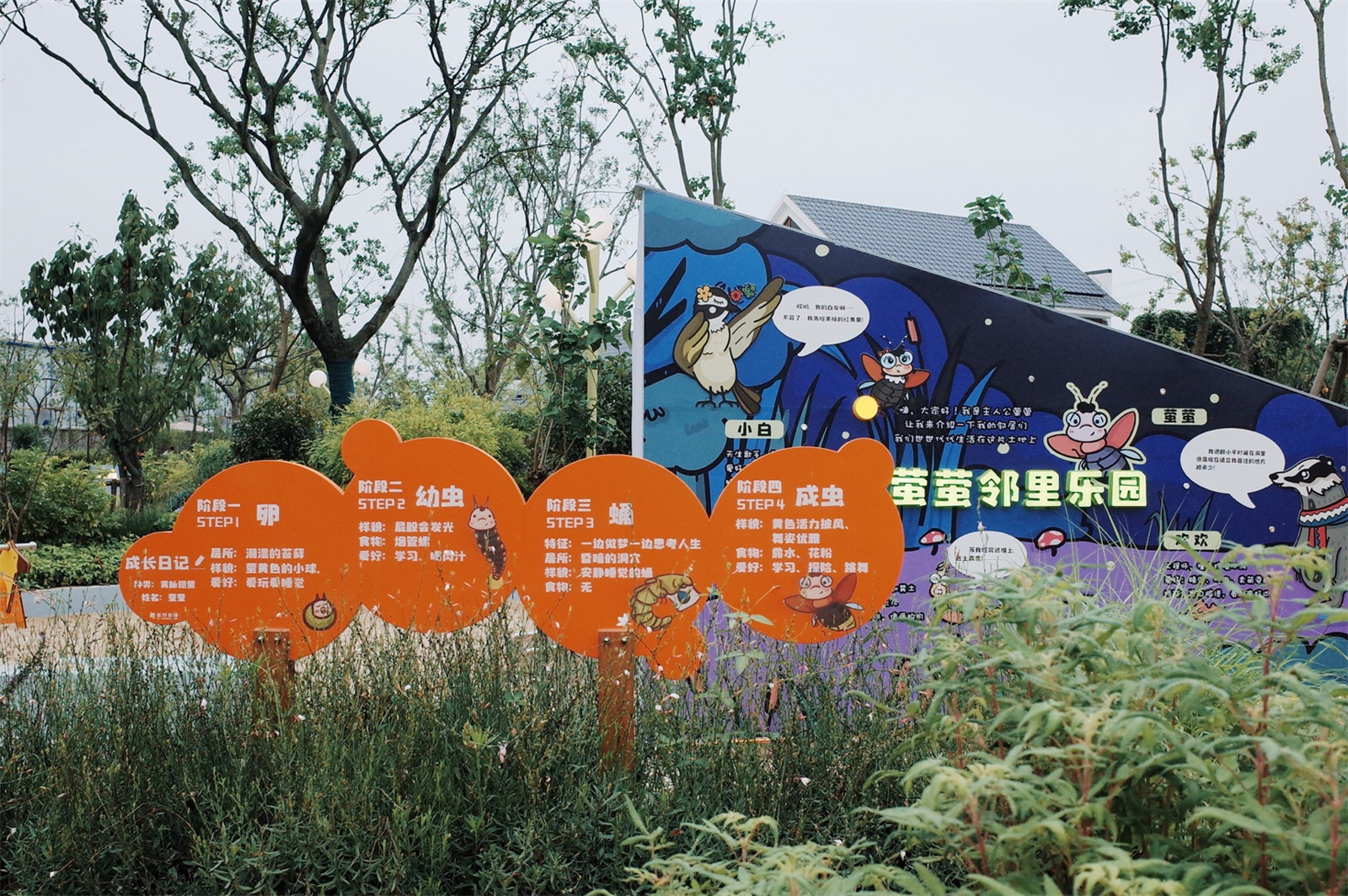
項(xiàng)目名稱:上海莊行社區(qū)花園
完成年份:2020年7月
項(xiàng)目面積:占地52000平方米�,一期建設(shè)占地面積8300平方米
項(xiàng)目地點(diǎn):上海市奉賢區(qū)南亭公路
設(shè)計(jì)公司:上海四葉草堂青少年自然體驗(yàn)服務(wù)中心泛境景觀設(shè)計(jì)
主創(chuàng)設(shè)計(jì)師: 魏閩 嚴(yán)建雯
施工圖設(shè)計(jì):后學(xué)兵、王向穎
植物設(shè)計(jì):謝文婉
標(biāo)識(shí)設(shè)計(jì):季琳�、何潔
生態(tài)設(shè)計(jì):李杰
開發(fā)商:東原集團(tuán)
攝影師:劉悅來 嚴(yán)建雯 李杰 拾柒 奧沙-亞瑟
Project name: Shanghai Zhuanghang Community Garden
Completed: July 2020
Area: Site area-52,000㎡, Phase I: 8,300 ㎡
Project location: Nanting Road, Fengxian District, Shanghai
Design company: Shanghai Clover Nature School & Pandscape Design
Lead designer: Wei Min, Yan Jianwen
Construction drawing design: Hou Xuebing, Wang Xiangying
Planting Design: Xie Wenwan
Signage design: Ji Lin, He Jie
Ecological design: Li Jie
Developer: Dowell Group
Photographer: Liu Yuelai, Yan Jianwen, Li Jie, Shi Qi, Aosha-Arthur
編輯:劉芳
版權(quán)聲明:本文版權(quán)歸原作者所有,請勿以景觀中國編輯版本轉(zhuǎn)載���。如有侵犯您的權(quán)益請及時(shí)聯(lián)系�,我們將第一時(shí)間刪除�。
投稿郵箱:info@landscape.cn
項(xiàng)目咨詢:18510568018(微信同號(hào))
 京公海網(wǎng)安備 110108000058號(hào)
京公海網(wǎng)安備 110108000058號(hào)



























